
Istanbul 2015 Itinerary
|
| Friday,
October 23 |
Overnight
on ship in Istanbul |
| Saturday,
October
24 |
Depart
Istanbul |
| Sunday,
October
25 |
Ephesus,
Turkey |
| Monday,
October
26 |
at
sea |
| Tuesday,
October
27 |
Haifa,
Israel |
| Wednesday,
October
28 |
Jerusalem,
Israel |
| Thursday,
October
29 |
Jerusalem,
Israel |
| Friday,October
30 |
at
sea |
| Saturday,October
31 |
at
sea |
|
Sunday,
November 01 |
Valletta,
Malta |
|
Monday,
November
02 |
Messina,
Sicily |
|
Tuesday,
November
03 |
Naples,
Italy |
|
Wednesday,
November
04 |
Rome,
Italy |
|
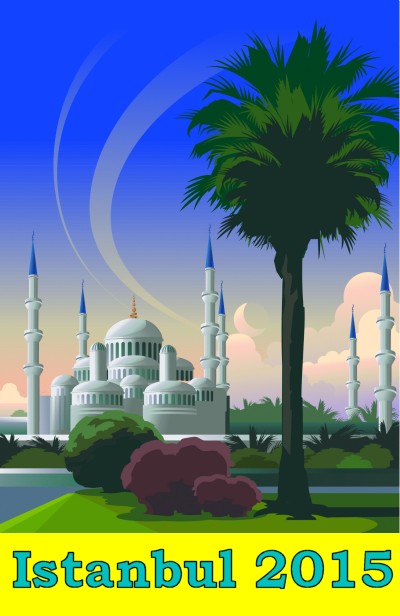 |
|
|
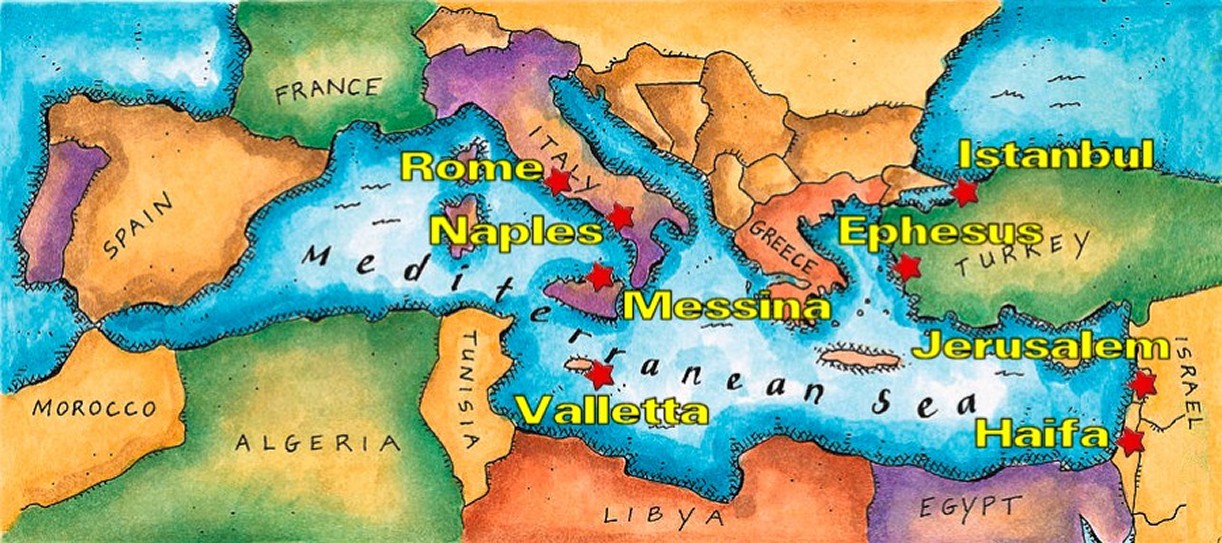 |
| |
|
A
Journey to the Origins of Western Civilization
About the October 2015 Trip to Istanbul, Jerusalem and Rome
|
Cruise Pricing
(All rates are per
person double occupancy)
|
|
Inside Category 10 Deck 3 |
$1546 |
|
Oceanview Category 7 Deck 2 |
$1756 |
|
Veranda Category 2B Deck 9 |
$2141 |
|
Concierge Veranda C2 Deck 8 |
$2336 |
A Note from Marla Archer:
Dear Travel Friends,
Rick and I invite you to join us on
a spectacular
2015 trip to three of the most
important cities in all of history.
We will be
taking a 12 Night Cruise Adventure aboard the
Celebrity Constellation, October 23 -
November 04.
Our goal is to explore ancient civilizations,
picturesque ocean vistas and experience
the world's greatest cultural centers throughout the
Eastern Mediterranean.
With every passing year our cruise adventures have
taken us to more glorious destinations. This year's cruise
continues that tradition. Our embarkation port is
Istanbul, Turkey.
When I
book a cruise, I am never quite
sure what kind of reception I will
get. In this case I was concerned
because Istanbul is so far away.
In fact, Istanbul is the most distant departure city that
I have ever booked.
The previous record was
Copenhagen, Denmark, at 5,000 miles from Houston (Russia
2012).
And how far off is Istanbul? This
fabled city is a cool 6,000 miles from Houston.
Would people be willing to travel
this far?
However, then I
noticed something very interesting:
Istanbul has
just been ranked the #1
travel destination in the world for 2014.
And Rome has
just moved into #2. Curious, I looked for a cruise to
Istanbul and found one that actually ended in Rome. A
cruise that started in the top destination in the world and
ended in the second most popular destination in the world
sounded pretty good to me, but when I saw the trip included
two entire days in
Jerusalem, my decision became a no-brainer.
2 days in
Istanbul, 2 days in Jerusalem, disembarking in Rome and all these
other great ports as well. I could not pass this trip
up.
So
I took advantage of a terrific offer from my Celebrity sales
manager - 10 points! - and booked the cruise. Trust me,
these points will translate into perks that will be passed on to you.
I have a more extensive write-up for each
location further below, but here is a brief overview of the trip
at a glance:
Istanbul
With every passing year our cruise adventures have
taken us to more glorious destinations. This year's cruise
continues that tradition. Our embarkation port is the #1
ranked travel destination in the world, Istanbul.
Trip Advisor:
"Au
revoir! Istanbul
and Rome have just
knocked Paris and New York off
top spots of 10 best destinations in the world (and
London moves into third place)
Millions of TripAdvisor users voted on their favorite
destinations around the world, and Istanbul took the top
spot. This is surprising because the city jumped 11
spots from the previous year, surpassing perennial
favorites like London and Paris.
Despite announcing record tourist figures for 2013,
Paris, the French capital lost
out to Turkey and dropped
to seventh in this year's Travelers' Choice Destinations
awards, voted for by millions of holidaymakers.
A newcomer to the top 10, Istanbul swooped in to
take the number one position, just ahead of
Rome, the Italian capital,
which itself rose two places from fourth last year.
Rome took New York's place at
#2. New York fell
out of the top 10 of the TripAdvisor list to number 12.
So why are travelers flocking to Istanbul?
Perhaps it's because the vibrant city embodies both
ancient and modern. It's chock-full of historic mosques
and monuments, but it also has tons of hip boutiques,
cool restaurants, and design-savvy boutique hotels that
hipsters, foodies, artists and fashionistas love. The
city feels decidedly chic - and travelers from all over
the world are taking note."
Ephesus and Haifa
We have an overnight in Istanbul,
where we use the ship as a floating hotel, so there is
plenty of time to check out the Istanbul's many sights.
Then we are off to Ephesus to
explore its ancient civilization.
Continuing on with a day at sea to
rest, then we spend a full day in Haifa. The shoreline here
is as incredible as is the beauty of the Baha'i Gardens.
Jerusalem
Then we continue on to one of the
major highlights of the trip-- Two full days in Jerusalem.
We will have plenty of time to visit the Western Wall, The
Church of the Holy Sepulcher, Dome of the Rock and even
travel to Masada and float in the Dead Sea.
Valletta and Messina
The cruise concludes with visits to
two of the most stunning locations imaginable, Valletta,
Malta and Messina, Italy. Visit
picturesque villages in Valletta and then spend a relaxing
day in the beautiful Taormina or explore
the foreboding Mt. Etna.
Naples
When we arrive in Naples, you may take the ferry
over to the Isle of Capri, and see Italy's most romantic
getaway spot including the Blue Grotto or spend your day exploring Pompeii.
Rome
Our cruise disembarks in Rome. You
may decide to fly home,
but Rome is certainly worth staying over and getting
a hotel.
Why not stick around a while longer? Even though Rick
and I have visited Rome twice, we will
definitely stay. There is still so much left
to see.
I know I will be headed to
the Vatican for a more intensive visit.
And Rick said he would be glad to lead a walk through the
streets of Rome retracing our steps from our first visit.
He promises to use a better map, so maybe I will come too.
We have reached that time in our lives that we feel it is
time to explore the world while we are still able. This
cruise is definitely on my bucket list and I know it is on
many others within our travel family.
Let's go see the
world together!
Marla Archer
713 862-4428
marla@ssqq.com
PS - For
a humorous look at my husband's thoughts about this trip, be
sure to check out
Rick's Anecdotes
|
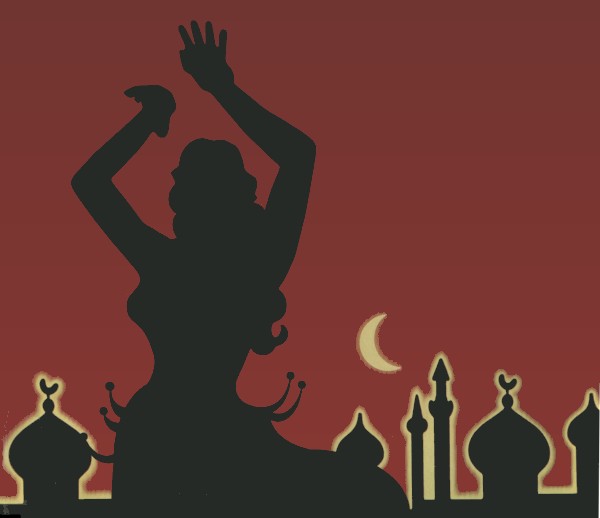
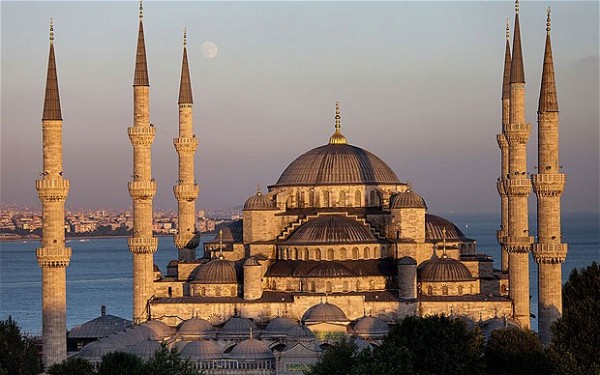
Istanbul
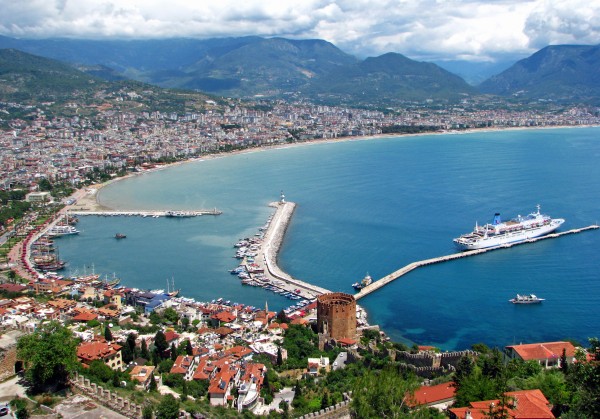
Istanbul
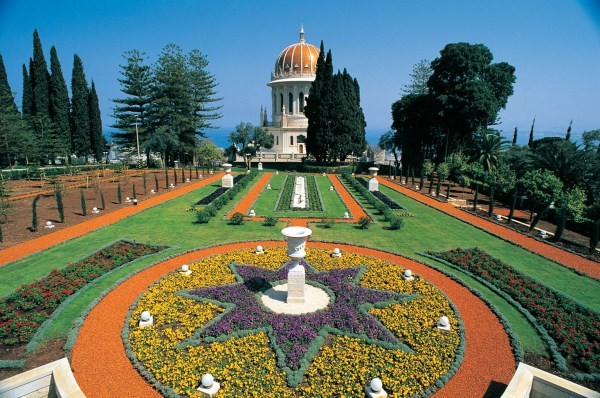
Bahai
Gardens at Haifa
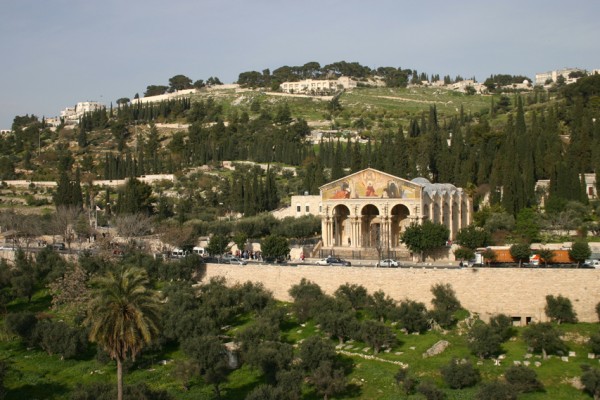
Mount
of Olives at Jerusalem
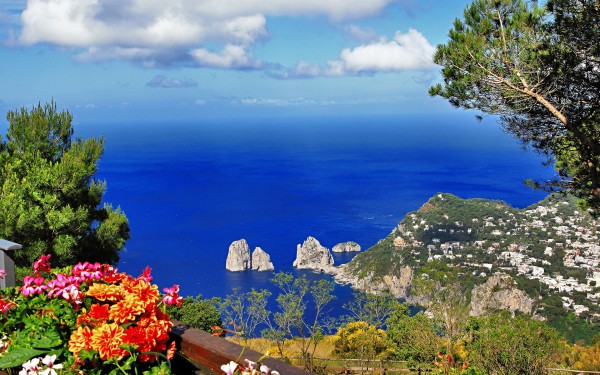
The
Stunning Isle of Capri in Naples
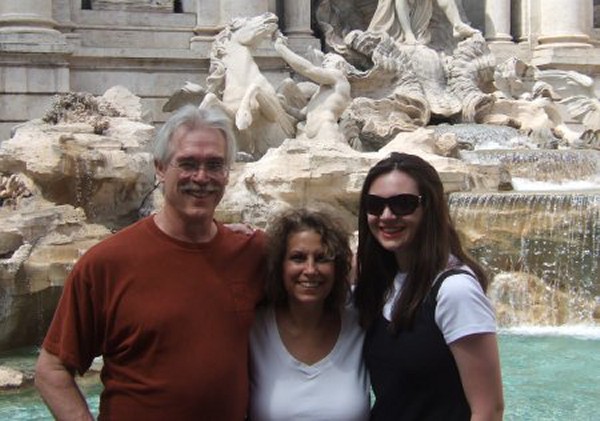
Rick, Marla and Sam (Rick's daughter) at Rome's Trevi
Fountain
|
 |
Marla's
Notes:
Istanbul is hot
and I am not talking about the weather. Istanbul is on fire
because it was rated the number one travel destination for
2014. Istanbul has acquired a reputation as one of the
world's most hippest cities. Besides the exquisite
Ottoman mosques, there are all kinds of restaurants, bars,
galleries and clubs around town.
Istanbul is such
a diverse city that it's almost impossible to split it up
into definable districts. The only real distinction that can
be made is between the European and Asian sides, which are
separated by the Bosphorus Strait. Stretching from the Black
Sea, straddling across the Bosphorus, touching the Sea of
Marmara, Istanbul, with an estimated population of between
10-13 million. You can spend the morning in Europe and the
afternoon in Asia, with just a ferry ride in between; how
cosmopolitan is that?
Did you know we will be able
to use the cruise ship as a hotel for one night? By
going in one day early before registration, Rick and I will
have two full days and nights to explore this exciting
half-Asian, half-European city.
While I am in
Istanbul,
I would like to cruise the Bosporus Sea. I would like to see the Topkapi Palace and Blue Mosque. And then I definitely
want to see the legendary Grand Bazaar.
Now here are
some of the various sites to see in Istanbul.
|
Sultanahmet
Most people who come to Istanbul land feet first in
Sultanahmet. This peninsula (known as Sarayburnu) juts
out into the Bosphorus, the Golden Horn and the Sea of
Marmara. Rich in history, it's a natural magnet to millions
of tourists every year.
The home of Topkapi Serayi (Topkapi Palace), Ayasofya (Hagia
Sophia) , the Blue Mosque (Sultan Ahmet Mosque) , Yerebatan
Serayi (Yerebetan Basilica Cistern) , and the At
Meydani(Hippodrome), Sultanahmet is filled to the brim with
hotels, restaurants, cafes, bars, and rug stores, as well as
a plethora of fascinating museums, mosques, markets and
historical sites.
The main drag,
Divan Yolu, is the heartbeat of the area, and there are
hundreds of tiny back streets and alleyways to explore the
history of the old city. The labyrinthine Kapaliçarsi (Grand
Bazaar /Covered Bazaar) near Beyazit University is also on
this street.
Sultanahmet can
be a little intimidating as it truly caters to only
tourists. You'll have to learn quickly not to respond to
"Hey! Are you American?" as the salesmen are notoriously
aggressive.
Eminönü
Situated right on the waterfront on the Golden Horn,
Eminönü is the end of the tramline. It is generally
buzzing with activity during the day, with street peddlers
selling you things you never even knew you wanted. The vast
Misir Çarsi (Egyptian Spice Bazaar) is the main feature of
Eminönü Square and Mimar Sinan's Yeni Camii (New Mosque) is
a familiar landmark with its minarets standing tall above
the general chaos. Ferries to the Asian side and the Princes
Islands leave from the huge docks lining the shore, where
you can stop by and have a balikekmek (fresh fish sandwich)
while you wait for your vessel. The Sirkeci Train Station is
also here: all trains to and from Europe begin and end their
journeys here.
Beyoglu / Taksim
A veritable symphony of Occident and Orient,
Beyoglu is the pulsating heartbeat of Istanbul's day and
nightlife. Istiklal Caddesi -- a paved thoroughfare
perpetually swarming with Istanbul's colorful hoi polloi --
is at the hub of the metropolis while a maze of narrow
winding lanes filled with funky cafes, soulful bars,
continental restaurants, historic cinemas, prominent
theaters and exclusive shops shoot off in all directions
around it.
Taksim Square,
featuring the impressive Monument to the Republic, leads the
way into Beyoglu's bohemian open-air museum, past the Greek
Orthodox Aya Triade Church and the French Consulate. A
quaint old tramway carries passengers past the Rumeli Han,
Çiçek Pasaji, Cite de Pera, Atlas Pasaji, Galatasaray Lisesi,
and several elegant consulates.
Every year the
International Istanbul Film Festival , International
Istanbul Music Festival, International Istanbul Theater
Festival and the International Istanbul Jazz Festival are
held here and in nearby districts. Beyoglu, which has
been the traditional home of Istanbul's gay community, hosts
various other annual events, including the Bosphorus
Festival, Roxy Music Days, Aksanat Jazz Festival and the
Blues Festival.
Tünel
This is undoubtedly Istanbul's Bohemian Quarter,
which not so long ago was perceived as a bad part of town,
with its dark deserted streets and creepy abandoned
buildings. However, the area has undergone tremendous
development in recent years. Tiny cafes, live music venues,
and open-air restaurants and bars now quietly coexist with
art galleries, antique bookshops and music stores.
Karaköy
Around the first century BC, there was a tiny village
situated on the mini peninsula of the Golden Horn where the
modern suburb of Karaköy stands today. These days,
Karaköy is a bustling port with a lively fish market, a
hectic ferry terminal and a shady nightlife; an intriguing
landscape at the mouth of the Golden Horn. Scores of locals
fish from the Galata Bridge and an array of vendors peddle
all kinds of goods along the sidewalks.
A vast
underground marketplace where you can buy electrical
appliances and guns, among other things, provides
not-so-safe passage under the busy road to the entrance of
Tünel. Up the hill is Bankalar Caddesi, an historical area
filled with banks, art galleries and do-it-yourself stores.
All visiting international cruise ships dock in Karaköy.
Galata
The
Genoese-built Galata Tower is the most central point here.
The renowned Turkish film Istanbul Beneath My Wings tells
the story of Hazarfen Çelebi, who flew from this tower with
a home-made pair of wings. The main street, Galip Dede
Caddesi, is a hub of activity with shops selling musical
instruments and antique books, and you'll also find a good
dose of tiny local restaurants.
The Whirling Dervishes have a home here at the Galata
Mevlevihanesi (Dervish Lodge) ; the Goethe Institute
provides locals with a good dose of culture and art; and
there are countless mosques, churches and synagogues hidden
away in obscure side streets.
Golden Horn
The most interesting part of the Golden Horn district
comprises of the stretch of land between Eminönü and
Ayvansaray, up as far as Eyüp. The Selimiye Mosque, the
Fethiye Mosque and St. Steven's Church grace the shoreline
while the Kariye Müzesi (Chora Church) and Mihrimah Mosque
are further inland. The old city walls start at Ayvansaray
and snake overland to Yedikapi.
Besiktas and Ortaköy
Besiktas -- which is actually dismally devoid of
places to help you paint the town red -- is at the center of
the three-way fork that leads up the hill to Levent. Ortaköy,
on the other hand, is a bustling suburb on the waterfront.
Bubbling over with cafes, bars, restaurants and tea houses,
this area is a popular weekend hangout for locals.
Ortaköy's back
streets are buzzing with handicraft stalls filled with
trinkets and souvenirs on summer weekends. This part of town
is renowned for its mosque, church and synagogue within
close quarters of one another. The Bosphorus Bridge spans
the waterway overhead.
Bosphorus: Arnavutköy to Sariyer
The Bosphorus
shore on the European side is lined with Ottoman-style
mansions, high society hangouts and fish restaurants. There
is only one main road and it follows the shoreline all the
way to Zekariyeköy, a popular weekend getaway for the
citybound.
Sea of Marmara Coast: Kumkapi to Yediküle
Kumkapi is a
distinctly touristy area filled with over-priced fish
restaurants and not much else besides views of the sea. The
coast road heads out toward the airport past the old city
walls and Yediküle Fortress.
Asian Side & Bosphorus: Kadiköy to Anadolu
Hisari
Kadiköy
is a quieter version of Beyoglu with a more subdued
atmosphere. The tiny cobbled lanes are filled with
restaurants, cafes, bars, cinemas and shops, but most
importantly, residents! The Asian side of town is where most
Istanbulites live; you'll have a harder time with no Turkish
language skills here, but it's worth it to pop over on the
ferry and experience a more relaxed way of life.
The coast road
snakes past Üsküdar, a pretty suburb with plenty of fine
examples of Mimar Sinan's work, including the Mihrimah
Sultan and Semsi Pasa Mosques.
Selimiye
Barracks (where Florence Nightingale worked during the
Crimean War) is up on the hill. Heading toward Anadolu
Hisari, the road winds along the shoreline (which is less
built up than that of the European side). There are plenty
of parks and trees, outdoor cafes and restaurants and a
string of historical buildings to explore including
Beylerbeyi Palace , Kuleli Mosque, Kuleli Naval Officer's
Training School, Küçüksu Park and Kiosk and Anadolu Hisari.
Princes Islands
There are four
islands in the Sea of Marmara that attract crowds escaping
the summer heat: Büyükada, Heybeliada, Kinaliada and
Burgazada. Ferries leave from Sirkeci, Kadiköy and Bostanci
regularly. There are no cars on the islands -- the transport
here is limited to horse-drawn carriages. Each island offers
plenty of places to eat and sleep, and there are Greek
monasteries atop the hills of Büyükada and Heybeliada.
Harbiye-Nisantasi-Sisli-Mecidiyeköy-Levent
The Military
Museum in Harbiye is a good landmark from which to begin
exploring Istanbul's business life. Nisantasi is the central
shopping district, while Sisli is strictly a business
district that goes all the way to Levent and beyond to
Maslak. There is now an underground metro linking Taksim
with Fourth Levent
Top Things to Do in Istanbul:
Hagia Sophia
The magnificent
Ayasofya was originally built by Byzantine Emperor Justinian
in 537 BCE, and it was used as a church for 916 years. It
was then used as a mosque for 481 years, and Turkey's first
President, Atatürk, declared it a museum in 1935. It is no
longer used as a place of worship, so you needn't be too
concerned with your attire.
Built on a
square base instead of the usual rectangular one, it has
been the inspiration for Ottoman mosques for countless
centuries. The incredible frescoes and mosaics in the upper
gallery, despite being damaged, are among the most popular
in the city. From 2007-2008, each gold tile piece in the
ceiling was restored to its former glory.
Topkapi Palace Museum
Topkapi Sarayi,
on the Seraglio Peninsula, became a museum in 1924. The
Harem, Baghdat Pavilion, Revan Pavilion, Sofa Pavilion, and
Audience Chamber distinguish themselves with their
architectural assets, while other artifacts on display
reflect palace life. Gülhane Park is located on the slopes
below the palace extending to the seashore, and is popular
among Istanbul residents for picnicking and open-air
concerts. In the park is the Gothic Column (courtesy of
Claudius II), known to have been one of the main obelisks of
the Byzantines. One of the most interesting parts of the
palace is the Harem, so be sure to get there early to sign
up for a guided tour.
Sultanahmet Camii Blue Mosque
Dubbed the "Blue
Mosque" by Europeans because of its beautiful interior
ceiling tiles (famed Iznik tiles), Sultanahmet Camii, with
six minarets, is a one of its kind. Built by Ahmet I between
1609 and 1616, the architect was Sedefhar Mehmet Aga, one of
Mimar Sinan's most prominent students. Inside, it's
surprisingly small, though very detailed, and the city has
installed a lovely wrought iron chandelier at the entrance.
The shrine near the mosque houses the tombs of Ahmet I and
his wife Kosem Sultan. The Blue Mosque is a working mosque,
so non-worshiping tourists are not permitted to enter during
prayer times, which occur 5 times daily for 30 minutes
Arkeoloji Müzesi
Arkeoloji Müzesi
(Istanbul Archaeology Museums) has twenty galleries filled
with artifacts gathered from all over Turkey and the Near
East celebrate 5000 years of history with exhibits from
Byzantium, the Ottoman Empire and the many civilizations of
Anatolia and ancient Egypt. The main building houses the
finds of nineteenth-century archaeologist Osman Hamdi Bey,
in particular the famous 4th-century Alexander sarcophagus
discovered at the royal necropolis of Sidon in Lebanon. The
Museum of the Ancient Orient contains artifacts from Egypt
and Mesopotamia, including a magnificent frieze of a bull
from the Ishtar gate in Babylon.
Basilica Cistern or Sunken Palace
The
Sunken Palace is located opposite the Blue Mosque. it's an
eerie, mysterious place, where you feel like you are in
ancient times This is an amazing Roman building that was
created in 532 AD. The Romans used built the palace with
columns from earlier Pagan temples.
|
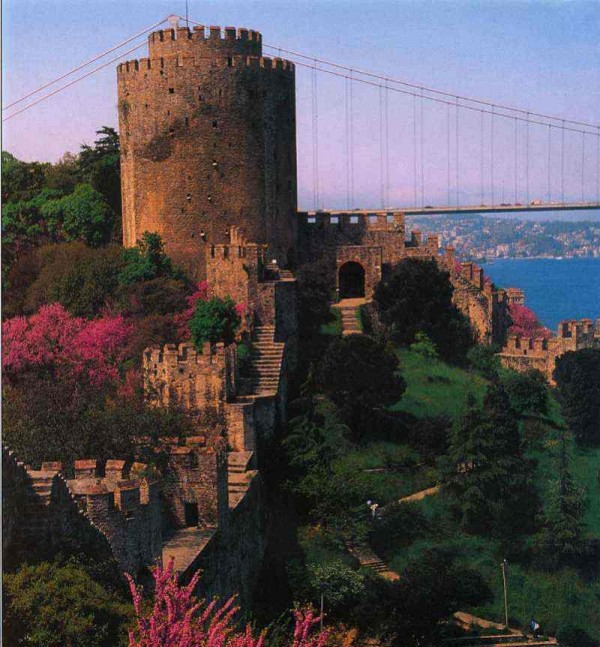
Rumeli
Fortress Rising Above the Bosphorus
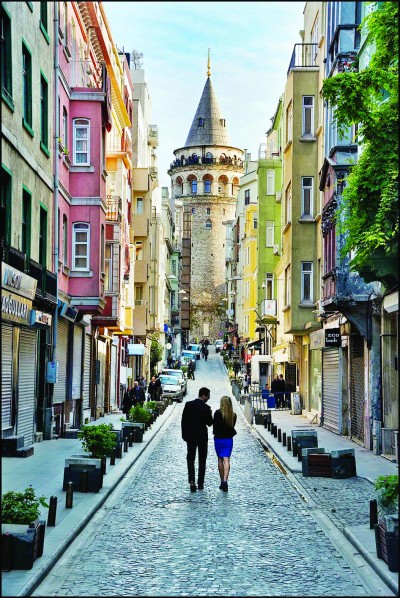
Street
featuring the Galata Tower
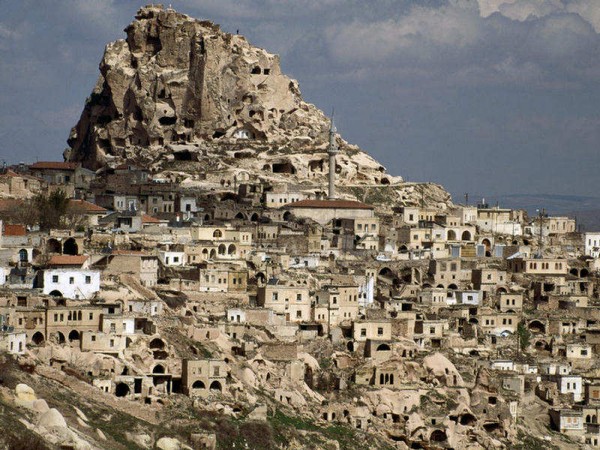
Cappadocia
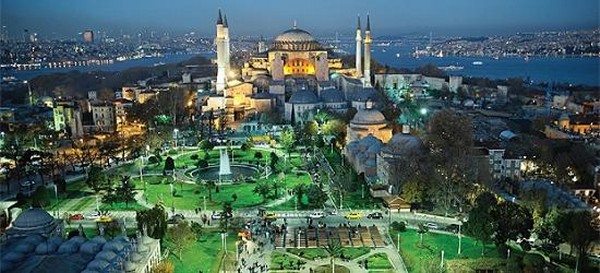
Hagia
Sophia
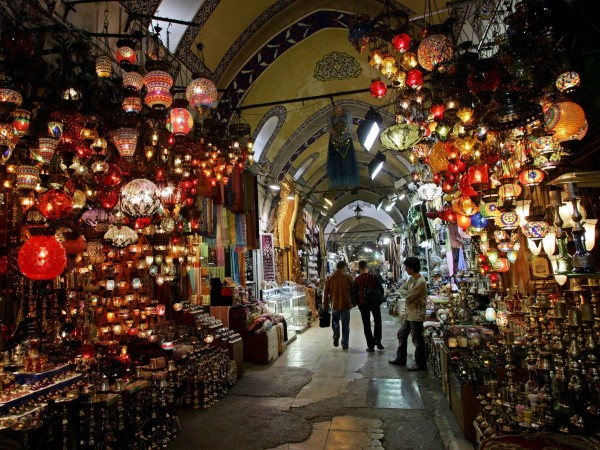
Grand
Bazaar
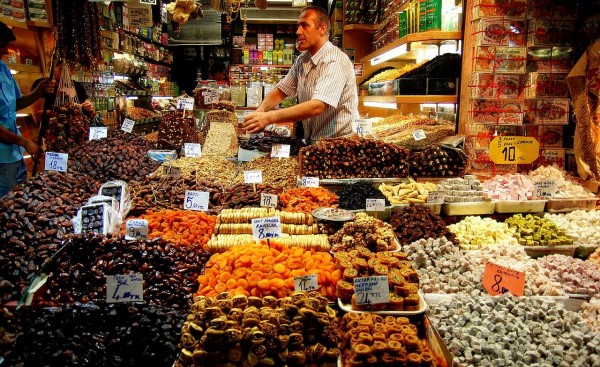
Spice
Bazaar
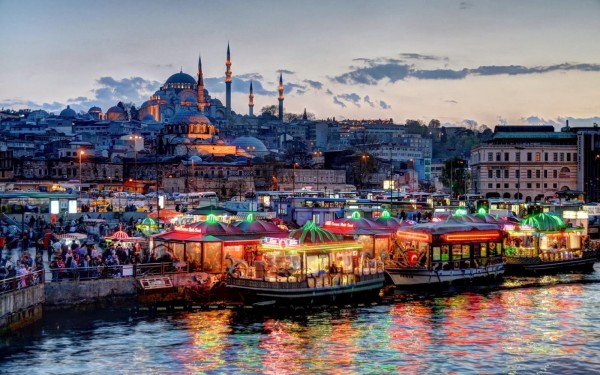
Cruising
the Bosporus
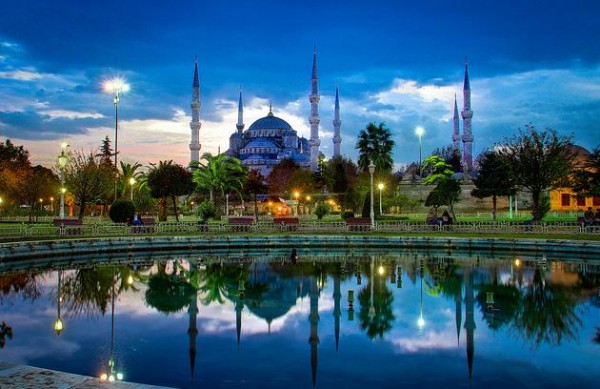
Hagia
Sophia
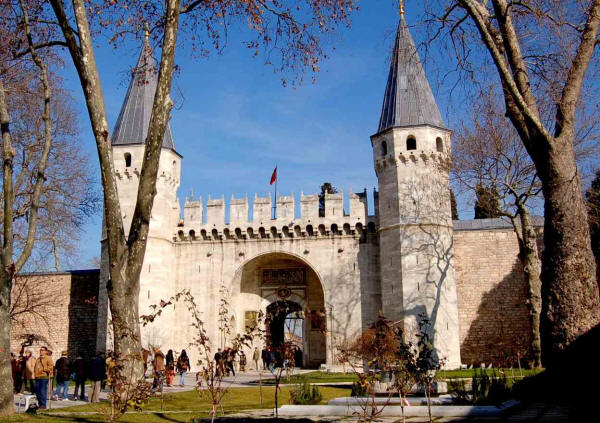
Topkapi
Palace
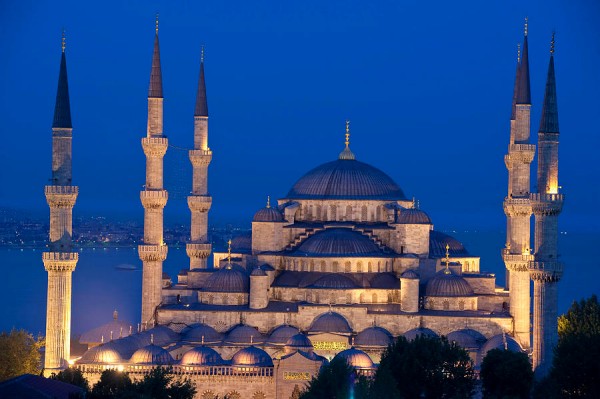
Blue
Mosque
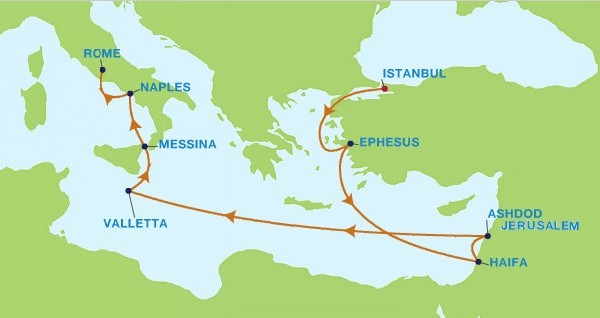 |
Kusadasi, Turkey, is
a port which serves as the gateway to Ephesus,
the site of well-preserved Roman ruins located 12
miles inland.
Ephesus, an
ancient city created
by the Ionians in the 11th century B.C. and later
expanded by the Romans. Now considered to be one of
the grandest reconstructed sites in the ancient
world, the region also hosted the likes of
Cleopatra, Mark Antony, the Virgin Mary and John the
Apostle. Kusadasi has grown from a small sleepy
fishing village into a sprawling tourist center,
serving the thousands of tourists who flock to the
area to visit the nearby ruins of Ephesus. These
ancient ruins are considered the most important in
Turkey.
The site
of the ruins is large. Only an estimated 15% has
been excavated. The ruins that are visible give some
idea of the city's original splendour, and the names
associated with the ruins are evocative of its
former life. The theater dominates the view down
Harbour Street which leads to the long silted-up
harbor.
Don't miss
the chance to visit the once powerful trading and
religious city of Ephesus. Travel through the
Magnesia Gate, the main entrance to the ancient
city, and continue along marble streets grooved by
chariot wheels. Gaze upon beautiful temples,
porticoes, fountains and frescoes. Discover the
three-story Library of Celsus, the Temple of
Hadrian, the Odeum, the Fountain of Trajan and the
Great Theater.
The Great Theatre was considered the
most magnificent structure in the ancient city of
Ephesus. It is located on the slope of Panayir
Hill, opposite the Harbor Street, and easily seen
when entering from the south entrance to Ephesus. It
was first constructed in the Hellenistic Period, in
the third century BC during the reign of Lysimachos,
but then during the Roman Period, it was enlarged
and formed its current style that is seen today.
Being the largest in Anatolia, the theatre has the
capacity of 25,000 seats.
The cavea has sixty-six
rows of seats, divided by two diazoma (walkway
between seats) into three horizontal sections. There
are three sections of seats. In the lower section,
Marble pieces, used for restoration, and the
Emperor's Box were found. The seats with backs, made
of marble, were reserved for important people. The
audience entered from the upper cavea. The stage
building is three-storied and 18 meters high. The
facade facing the audience was ornamented with
relieves, columns with niches, windows and statues.
There are five doors opening to the orchestra area,
the middle one of which is wider than the rest. This
enhanced the appearance of the stage, giving it a
bigger, monumental look. The theatre was used not
only for concerts and plays, but also for religious,
political and philosophical discussions and for
gladiator and animal fights.
The Library of Celsus was built in 135 AD to store
12,000 scrolls and to serve as a monumental tomb for
Celsus. It was unusual to be buried within a library
or even within city limits, so this was a special
honor for Celsus. Though the building itself does
not have much historical significance, it is
important today because it is one of the few
remaining examples of an ancient Roman influenced
library. It also shows how public libraries were not
only built in Rome itself, but also all throughout
the empire. After a massive restoration project,
which is considered to be very true to the
historical building, the front façade of the
building was rebuilt and now serves as a prime
example of Roman architecture on public buildings.
The name
"Temple of Hadrian" is not entirely accurate: it is
more a monument than a temple, and was dedicated to
Hadrian, Artemis and the people of Ephesus. An
inscription tells us that it was erected around 118
AD. The temple was partially destroyed in the 4th
century, and it was during the course of
restorations that the four decorative reliefs were
added to the lintels of the interior of the porch.
Explore the
14th-century Turkish baths and the Isa Bey Mosque on
your way to the Basilica of St. John. The
Basilica of St.
John (St.
Jean Aniti) was a great
church in Ephesus constructed by Emperor Justinian
in the 6th century. It stands over the believed
burial site of St. John, who is identified as the
apostle, evangelist (author of the Fourth Gospel)
and prophet (author of Revelation). The basilica is
on the slopes of Ayasoluk Hill near the center of
Selçuk, just below the fortress and about 3.5 km (2
miles) from Ephesus.
Visit the Temple of Artemis - one of the Seven
Wonders of the Ancient World.
A column
and scanty fragments strewn on the ground are all
that remains of this Seventh Wonder of the World.
According to Strabo,
the Temple of
Artemis was destroyed at least seven
times and rebuilt just as many times. Archaeological
findings instead attest to at least four rebuildings
of this temple, starting in the 7th century B.C.
The temple served as
both a marketplace and a religious
institution. For years, the sanctuary was visited by
merchants, tourists, artisans, and kings who paid
homage to the goddess by sharing their profits with
her. Recent archeological excavations at the site
revealed gifts from pilgrims including statuettes of
Artemis made of gold and ivory...
earrings, bracelets, and necklaces... artifacts from
as far as Persia and India.
Get
to
know the local and rural life of the Turkish people
and their way of living and head to the lovely town
of Sirince. It is a wonderful little Aegean village
of 600 inhabitants that is located in the hills at
about 1000 feet above sea level. Most of the houses
in the village date from the 19th century or earlier
and they were built at a time when Sirince was
predominantly a Greek village. The village lies in a
lovely bowl of hills surrounded by peach orchards,
vineyards and olive groves.
The higher hills are
covered with pine forest. Nearly all houses command
a pastoral panorama extending over many miles,
undisturbed by any modern development. Farming
remains the principal activity. Villagers make wine
and olive oil, and grow some of the best peaches in
the country. After exploring the village of Sirince,
stop in one of the wine houses and tase the
home-made fruit wines. Then head for Tire, another
interesting town about 62 miles away from Sirince.
|
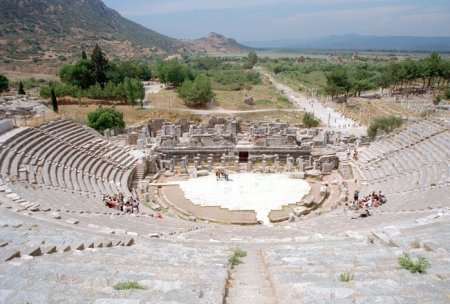
Great Theater
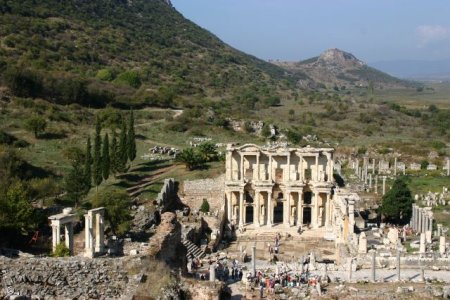
Library of Celsus
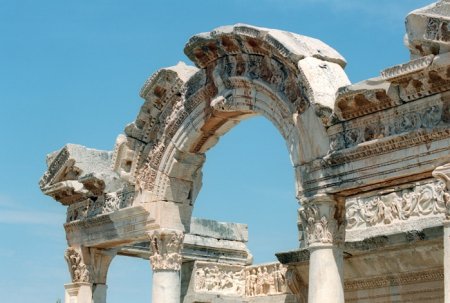
Temple of Hadrian
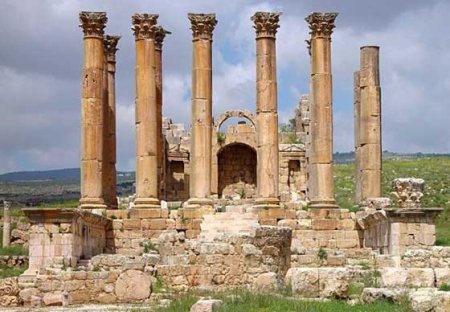
Temple of
Artemis

Next stop: Haifa |
Located on the historic slopes of Mount Carmel and
overlooking the beautiful Mediterranean, Haifa's terraced
landscape features panoramic views of the sparkling bay and
the medieval fortress city of Acre.
To the east lies the snow-capped peak of Mount Hermon. The
city's terraced landscape offers a rich variety of
breathtaking panoramas, giving the observer the sensation of
being on a heavenly peninsula.
To the northeast, across the sparkling
waters of the harbor sits the medieval walled fortress city
of Acre.
An important industrial port, Haifa is Israel's northern
capital and third largest city. Visitors will find a unique
blend of traditional and contemporary culture. It is home to
ancient temples, churches and mosques, as well as elegant
hotels, shopping malls, cinemas and white-sand beaches.
Baha'i Gardens and Golden Dome
Perhaps the most popular and most visited attraction in
Haifa is the magnificent Baha'I Shrine and Gardens. With its
stone peacocks and eagles and meticulously manicured cypress
trees, these beautiful, geometric cascading gardens were
originally planned by Shogi Effendi, the late Guardian of
the Faith. Recent redesigns and improvements have put these
gardens on a level with some of the most magnificent
horticultural marvels in the world.
When you look at the gardens, remember they were built
through voluntary contributions from members of the faith;
giving whatever they could for the glory of God. Most people
working there are volunteers, demonstrating their love for
the prophet of this age, Baha'u'allah, and his teachings of
unity, equality of man and woman, respect for the
environment and so much more. Pilgrimage there is a sacred
duty, performed at least once in a Baha'is life wherever
possible.
The gardens have three entrances, one from the top of the
mountain, one in the middle which leads straight to the
shrine, and the third one at the bottom of the gardens in
the German Colony. After walking down the gardens it is
recommended to walk around the German Colony and feel the
History and see all the beautiful architecture. In the
German colony in Ben Gurion ave. there is a small souvenir
and gift shop which is a must.
Go too to Acre (or Akka) nearby and see the ancient walled
city that was a prison in the time of the Ottoman Empire and
where the Baha'i leader, family and followers were held for
many years yet rose above the squalor that their oppressors
thought would wipe out their faith.
Walk the main streets and by the harbour,
enter the tunnels built by crusaders and the citadel where
the Baha'is were first imprisoned and in the 20th century
where Israeli freedom fighters were kept during the British
mandate. This is a fascinating, deeply historical area of
Israel.
Other Sites of Interest:
Cave of Elijah - Elijah is
considered a prophet by both Judaism and Islam. The
Carmelites have a tradition that they were founded by Elijah
at this time. According to tradition Elijah lived in a cave
on Mt. Carmel during the reign of King Ahab.
Stella Maris, a French
Carmelite church, monastery and hospice. This is the
founding place of the Carmelite Order, a religious order of
the Roman Catholic Church. Located atop Mount Carmel, there
is a hiking trail connecting it to the Cave of Elijah below.
German Colony - in 1868 members
of German Templar Society (not to be confused with the
Knights of the Templars) purchased land that was far from
the city and set out to build the first planned agricultural
community in the Holy Land.
Many of the original templar houses have
preserved and undergone restoration in the last decade of XX
century. Now the main street of the former colony (Ben
Gurion Boulevard) is a promenade, with many restaurants and
coffee shops. The City History Museum and the local Tourist
Board are located here.
|
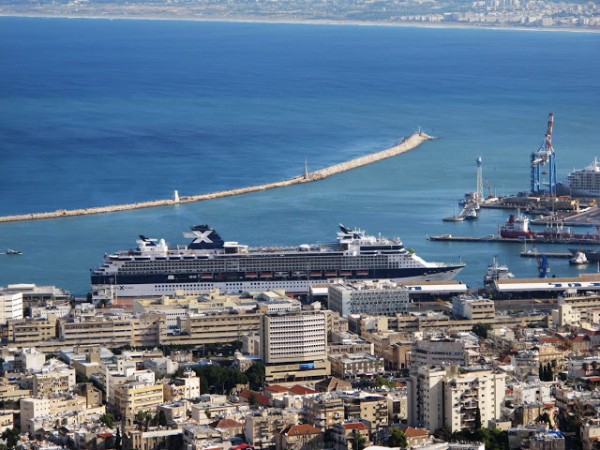
The Celebrity Constellation docked in Haifa

The fabulous Bahai Gardens overlooking the Mediterranean
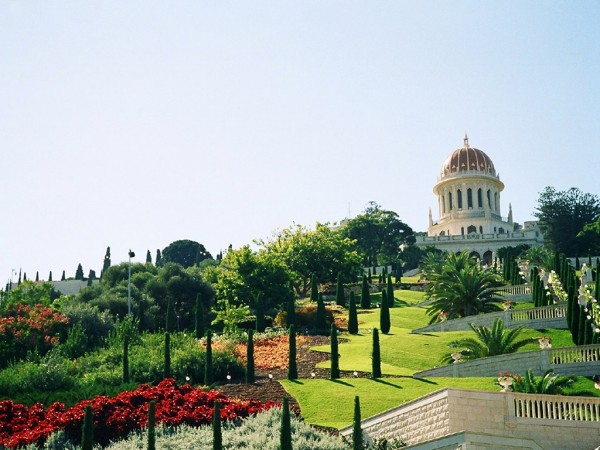
Bahai Gardens
 |
Marla's Note: Don't forget we will spend TWO
DAYS in Jerusalem. That allows for a lot of
flexibility.
Israel's capital city occupies an important place in the
hearts and minds of Muslims, Christians and Jews alike.
The walled section
comprising the Old City of Jerusalem is an area rich in the
historical traditions of these three religions. It is home
to the Church of the Holy Sepulchre, the Dome of the Rock,
and the Al Aksa Mosque on the Temple Mount. The Western Wall
provides the focal point for Jewish worship and stands as an
enduring symbol of the Jewish homeland.
The Old City can be accessed through seven of the eight
gates punctuating the ancient walls enveloping it. Within
these walls are the separate quarters of the Muslim, Jewish,
Christian and Armenian communities.
A dazzling array of
merchandise can be purchased from the lively Arab souk (open-air
market), and meandering through the narrow corridors and
cobbled pavements of the ancient centre inevitably provides
a feast of sensations. For an orientation of the Old City it
is best to set off along the Ramparts Walk, originally
designed for watchmen, or to climb the Citadel of David for
a panoramic vista of the eternally fascinating city of
Jerusalem.
Although famous for its many remarkable historical and
religious sites Jerusalem does have more modern attractions
too; the city has all you would expect in the way of
amenities, shopping, restaurants and nightlife - although if
you are visiting Israel primarily for these sorts of
activities Tel Aviv will be more to your liking.
Temple Mount (Al-Haram al-Sharif)
Temple Mount, known by
some as Mount Moriah, is a site of tremendous religious
importance to Muslims, Jews and Christians alike. It is one
of Jerusalem's most famous landmarks and can be found within
the walled section of the Old City. The glinting golden dome
of the Dome of the Rock rises impressively from Jerusalem's
skyline and has become the city's most distinguishable
feature.
Temple Mount is of Jewish
and Christian historical importance on two accounts: the
large rock is believed to be the place where Abraham offered
his son Isaac up for sacrifice, and the First Temple is the
place where the Ark of the Covenant is said to have been
housed.
Even though off limits to
Jews today, it is still a focal-point of Jewish life, and
Jews worldwide face the Temple Mount during prayer. For
Muslims the same rock is the place from which Muhammad, in a
dream, ascended to heaven. In commemoration of this
apotheosis, the Dome of the Rock was built over the site in
the 7th century. It is known to Muslims as the Noble
Sanctuary or Al-Haram al-Sharif, and is one of the three
most important sites in Islamic culture. Also located on the
Temple Mount are the Al Aqsa Mosque and the Islamic Museum,
which houses a collection of Korans and other Islamic
relics.
Masada
Situated in the Judean
Desert and overlooking the Dead Sea, is one of Israel's most
popular and remarkable tourist attractions - the mountaintop
fortress of Masada.
This enduring symbol of
Jewish history is the site of the heroic defence by 967
Jewish Zealots, who rose against the Roman Empire in 66 AD
and took their own lives when defeat seemed inevitable. The
ancient fortress which the rebels defended against Roman
siege was built by King Herod on top of the plateau.
You can still explore the
ruins of the ancient palaces and structures at the site and
see the remains of the most complete Roman siege system in
the world; the Roman camps, siege wall and ramp are still
clearly visible. Masada is a UNESCO World Heritage Site and
a place of profound interest for military history buffs as
well as those touched by the bravery of the men, women and
children who stood their ground against the Roman Empire.
A cable car ride or hike
up the Snake Path takes one to the top, where breathtaking
views can be enjoyed over the Dead Sea and the surrounding
desert. The Masada Sound and Light Show recounts this
dramatic history with special pyrotechnic effects, and takes
place in a natural amphitheatre on the west side of the
mountain reachable only from Arad.
The Yigal Yadin Masada
Museum is also fascinating.
The Israel Museum
The Israel Museum has
achieved world-class status with its remarkable collections,
spanning from prehistoric archaeology to contemporary art.
These include displays of archaeology from the Holy Land, a
comprehensive compilation of Judaica and the ethnology of
Jewish people, and a fine art collection encompassing the
Old Masters and renowned contemporary works.
Perhaps the most exciting
artifacts in the museum are the Dead Sea Scrolls, which date
from between the 3rd century BC to the 1st century AD, and
were famously discovered in a cave by a shepherd in 1947.
Numerous temporary exhibitions, publications, lectures and
educational activities form part of the museum's cultural
program, and over 950,000 visitors are drawn to this vast
complex each year.
Another great attraction
of the Museum is its Art Garden, which was designed by the
Japanese-American sculptor Isamu Noguchi. It is a fusion of
Zen landscaping, incorporating the natural vegetation of the
area such as rosemary bushes, olive and fig trees. Displayed
within this picturesque setting are the famous sculptures of
Rodin, Bourdelle, Maillol, David Smith, Henry Moore, Richard
Serra, Sol LeWitt and James Turrell. The Israel museum is
impressive and has an extensive collection; you will
probably require a few hours to explore it properly.
Tower of David Citadel
The Citadel was constructed in the 1st century BC as a
fortress for King Herod, and has since served as a strategic
defense position of the Old City. The tallest tower of the
Citadel, the Phasael, is the place to appreciate the
magnificent panoramic view of Jerusalem as well as the
orientation of the Old City.
The Citadel contains the
excellent Museum of the History of Jerusalem, featuring
fascinating displays of 4,000 years of the city's past in
the courtyards and rooms of the fortress. Free tours of the
citadel and museum are conducted in Hebrew on Mondays and
Wednesdays at 10.30am, and in English every day except
Friday and Saturday at 11am. The light and sound show held
almost nightly is also a delightful way to learn about the
history of Jerusalem.
In fact, the Citadel of
David is a great first stop for visitors to Jerusalem as it
covers the history of the city from biblical times to the
present in a very accessible and interesting way. There are
captions in English and Hebrew and audio guides available so
you can easily explore without taking one of the tours. The
citadel itself is thrilling with some fascinating
architectural elements - those who struggle with steps
should note that there are a lot of them at this site and
seeing the place properly requires a fair amount of
climbing.
The Dead Sea
The Dead Sea and its immediate environment is a landscape
abundant with natural wonders. Most notable of these is the
high salt and mineral concentration found in the sea's
waters, that enables visitors to float effortlessly on the
surface. The therapeutic properties of the black mud found
in the region are formed by a mixture of sea minerals and
organic elements.
For a completely
rejuvenating experience, several Dead Sea spa resorts offer
a range of health and beauty treatments. If you want a
do-it-yourself treatment though, all you need to do is cover
yourself in Dead Sea mud after your swim and allow it to dry
on your body in the sun before washing it off again - your
skin will feel amazing afterwards.
The water is also
wonderfully warm, making swimming possible all year, even in
winter. Some people complain of a stinging feeling in the
Dead Sea, especially in eyes and mouths, which is simply due
to the high salt content. If you have cuts and bruises they
may well sting but the water is actually very good for skin
ailments. Some visitors take goggles to protect their eyes
but most just enjoy the floating sensation without
submerging their faces.
The Dead Sea region also
boasts some fascinating archaeological sites, with traces
remaining of Persian, Greek, Roman and other civilizations.
Notable historical locations include the notorious biblical
city of Sodom that was destroyed along with Gomorra. Salt
pillars emerge from this eight-mile (12km) geological ridge,
located in the southern part of the Dead Sea area.
Via Dolorosa
The Via Dolorosa (Road of
Sorrow), also known as the Way of the Cross, is the route
Jesus is said to have followed as he carried the cross to
his crucifixion. There are 14 stations along the way
commemorating different events, starting at Lion's Gate in
the Muslim Quarter of the Old City, where Jesus was
convicted by Pontius Pilate, and ending at his tomb, inside
the Church of the Holy Sepulchre within the Christian
Quarter. Every Friday at 3pm priests lead a procession and
prayers are said at each station.
A steady stream of
pilgrims remember and honour Jesus' sacrifice by walking the
Way of the Cross each year. Each station is clearly marked
by a semi-circle of pavement stones with the Roman numeral
of the station on the wall - some stations have additional
inscriptions. There are many churches along the way,
belonging to different Christian sects, and it is
fascinating to enter as many as possible and compare the
different interpretations of the Via Dolorosa and of Jesus.
There are also many
other, more secular, attractions along the way, with shops,
cafes, restaurants and other sights and distractions for
those who want a less solemn religious experience. The
pathway is historically unlikely to be the exact route
walked by Jesus but it is a profound walk of faith for many
Christians nonetheless - and an interesting cultural
experience into the bargain.
Church
of the Holy Sepulchre
The Church of the Holy
Sepulchre is the holiest Christian site in Jerusalem - the
site of Jesus' crucifixion, burial and resurrection. First
constructed in 335 by Emperor Constantine, persistent damage
has been inflicted on the structure over the centuries and
subsequent repair-work has been undertaken by the religious
communities that administer it.
The Church contains the
Chapel of Golgotha and the three Stations of the Cross where
Jesus was crucified. It also features the burial place of
Christ. The Sepulchre marks the place of his burial
and resurrection.
This incredible church it
is an absolute must for Christians. It is filled with
treasures and should be of great historical and
architectural interest regardless of one's religious
beliefs.
It is home to several
different Christian denominations which all have their own
styles of worship - some areas are common to all and some of
the chapels are particular to certain denominations. It is
important to either join a good tour or to do some research
beforehand to understand the significance of what you are
seeing because this is a church, not a museum, and there is
not much information available at the site.
The church can get very
crowded and you may have to queue for a long while to get in
so it is a good idea to arrive early in the morning. Those
visiting in the hope of a tranquil environment in which to
pray and worship may be disappointed if they visit at a busy
time. The tomb can only be entered by five people at a time
so there is usually a long queue for this privilege as well.
Western
Wall (HaKotel HaMaaravi)
The Western Wall, known
to non-Jews as the Wailing Wall, is the most sacred Jewish
prayer-site in the world.
Thousands of worshippers
gather year-round to pray there, and to place folded written
prayers into the crevices of the wall. The 1,916-foot (584m)
wall is all that remains of the Second Temple of Jerusalem,
built in 30BC by King Herod. It is made up of enormous stone
blocks, and endures as a tribute to the scale of workmanship
in past eras. Following Orthodox Jewish practice, the
praying sections have been separated for men and women. Men
are required to wear a skullcap (kippah) and women must be
modestly dressed.
On Fridays, the Jewish
Shabbat or Sabbath, the men's section particularly pulsates
with the songs and prayers of the faithful, for in
principle, the whole area is an Orthodox synagogue. The wall
is also sacred to Muslims, who believe that it is where the
prophet Muhammad tied up his winged horse, al-Buraq, before
ascending into heaven.
For those interested in
the architectural and historical aspects of the Western Wall
there is an interesting tunnel tour that takes visitors
through excavations along the Wall, which is much more
extensive than is visible from the famous square. Be
prepared to go through security and have your bags checked
at the site and be aware that at some times, like when there
are holy events underway, photography is not allowed.
Yad Vashem
This vital memorial to
the Holocaust provides a multifaceted tribute to the
millions of Jews who died during World War II. The focus of
the museum is to commemorate and document the events of the
Holocaust and provide ongoing research and education. The
Museum's archive collection is the world's largest and most
comprehensive collection of material, containing documents,
photographs, films and videotaped testimonies of survivors.
These can be read and
viewed in the allocated rooms - and doing so is an
emotional, sobering experience. An inspiring tribute to the
victims is The Hall of Names, where the names of the six
million Holocaust victims are displayed. Symbolic
gravestones are created from the 'Pages of Testimony',
records of the biographical details of millions deceased.
Yad Vashem's library
contains an impressive collection of material in many
languages. The Historical Museum chronicles the history of
the Holocaust, from the implementation of the Nazi's
anti-Jewish policies to the mass murder of the concentration
camps. The display includes photographs, artefacts,
documents and audio-visual material. An important collection
of Holocaust art is also displayed in Yad Vashem's Art
Museum.
The International School
for Holocaust Studies and Holocaust Research provides
education and ongoing research on the Holocaust at both
national and international levels. Other facets of the Yad
Vashem experience include the Righteous Among the Nations
exhibition, honouring the non-Jews who risked their lives
during the Holocaust to save Jews; and the Encyclopedia of
Communities, which records the historical-geographical
communities of Jews destroyed or damaged during the Nazi
regime.
Children under 10 are not
permitted, and visitors should be aware that some may find
the experience distressing.
Bethlehem
Bethlehem is just six
miles (10km) south of Jerusalem, and is a major tourist
attraction for pilgrims and visitors alike. The putative
birthplace of Jesus, this is a charming town despite its
tourist-centred commercialism. The Church of the Nativity is
the focal point for a visit to the town, erected over the
site of Jesus' birthplace. Bethlehem is also a wonderful
place to experience the variety of Christian monasteries
that represent every permutation of Christianity.
Christmas is celebrated
on three separate dates in accordance with the Catholic and
Western church calendars, the Eastern calendar followed by
the Armenians, and the Julian calendar followed by the Greek
Orthodox and Eastern churches.
For further exploration
of the town's cultural diversity and to learn something
about its secular history visit the Bethlehem Museum,
established by the Arab Women's Union to celebrate the
area's Palestinian cultural heritage. The exhibits include
displays from traditional household items to clothing,
jewellery and old photographs and allow insight into the
domestic history of the town. The Bethlehem Museum is open
Monday to Wednesday and Friday and Saturday between 8am and
5pm, and on Thursdays between 8am and 12pm.
Makhtesh Ramon (Ramon Crater)
The Makhtesh Ramon (Ramon
Crater) is an extremely interesting geological site located
in Israel's Negev Desert, about 53 miles (85km) south of the
city of Be'er Sheva. The crater (or more properly, makhtesh)
was not formed from the impact of a meteor, but is rather a
geological formation unique to the Negev desert, caused by
millions of years of erosion and weathering following the
retreat of the ocean. These days, the vast crater is housed
within Ramon National Park, one of Israel's most popular
ecotourism destinations. The crater, which is shaped like an
elongated heart, is a magnificent sight - and a potent
reminder of the incredible age of the region. The crater is
also home to a variety of indigenous plants and animals,
including the Nubian ibex, striped hyena, Arabian leopard
and Dorcas gazelle. There are numerous hiking trails leading
down to the bottom of the crater, where you can see the
ruins of prehistoric Khan Saharonim (a stop used by Nabatean
traders travelling the Incense Route more than 2,000 years
ago). An ideal destination for those who like their
experiences of nature to be silent and expansive, there are
also wonderful star-gazing opportunities (and cheap
accommodation) available at the nearby town of Mitzpe Ramon.
Hezekiah's Tunnel
Yet another fascinating
historical attraction in Jerusalem, Hezekiah's Tunnel is an
absolute must-see for those who like to combine their
sightseeing with a real sense of discovery and adventure.
The tunnel, which is
about 2,700 years old, was built by Hezekiah in preparation
for an attack by the invading Assyrians - he thought by
shutting down the springs outside the city and redirecting
the water under the city walls through a tunnel, he could
protect Jerusalem's precious water supply and so outlast the
invaders.
The incredible feat - the
tunnel is 1,640 feet (500m) long, and carved out of solid
rock - is made all the more remarkable when one learns that
its middle section, which zig-zags wildly, was constructed
in this way because the two teams of diggers (each operating
from a different end of the tunnel) were trying to locate
each other by the sound of the other's picks working against
the rock. One of the very few 8th-century BC tourist
attractions you can actually explore, Hezekiah's Tunnel is a
wonderful place to pass a couple of hours, wandering through
the bowels of Jerusalem's Old City. It is a particularly
popular activity for kids, although it may not be suitable
for the highly claustrophobic.
|
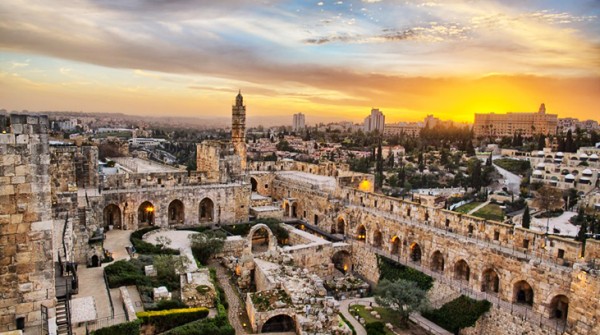
Ancient Jerusalem today
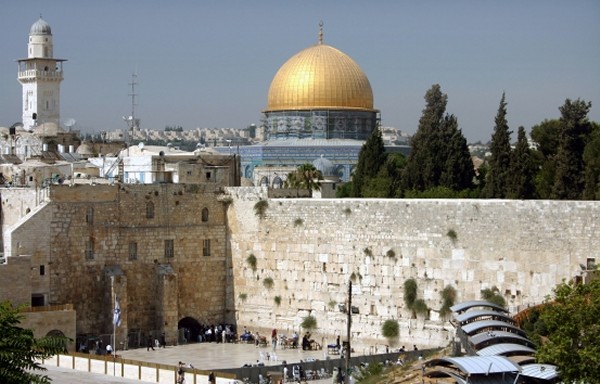
Temple Mount: The Western Wall and the Dome of the Rock
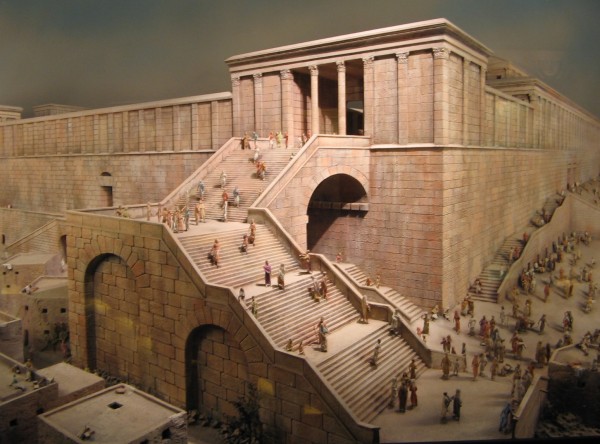
Artist rendering of ancient Jerusalem
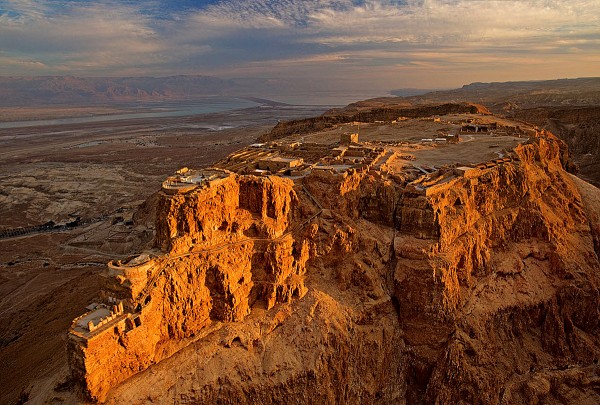
Masada, Israel's "Alamo", an enduring symbol of Jewish courage
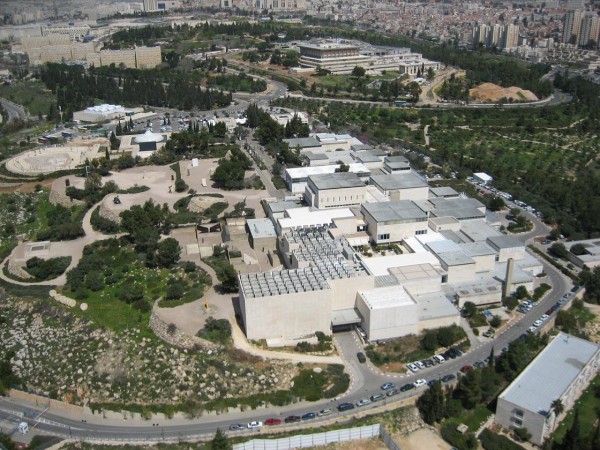
The Israel Museum
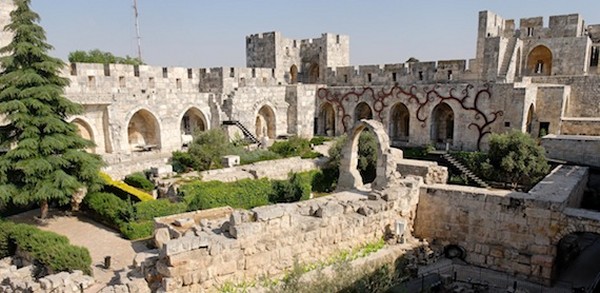
Tower of David Citadel

The Dead Sea
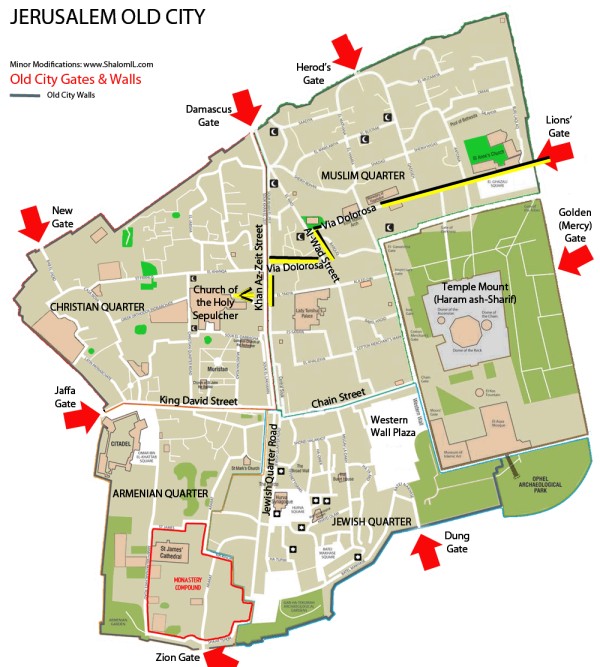
Via Dolorossa
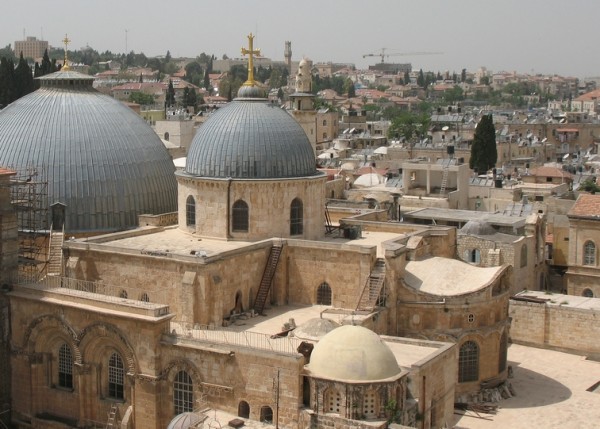
Church of the Holy Sepulchre
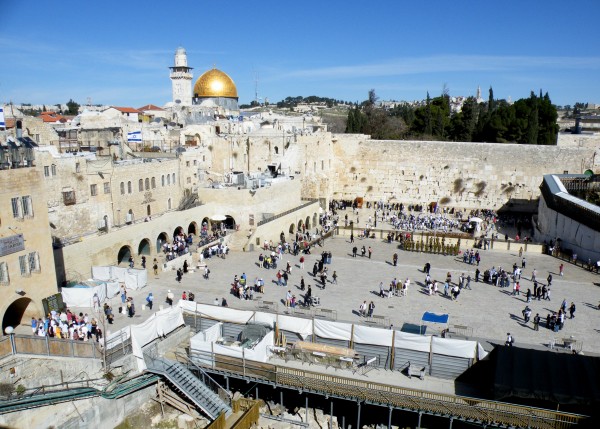
Western Wall
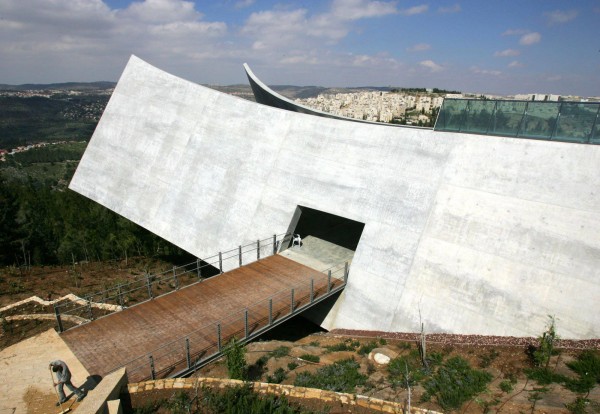
Yad Vashem
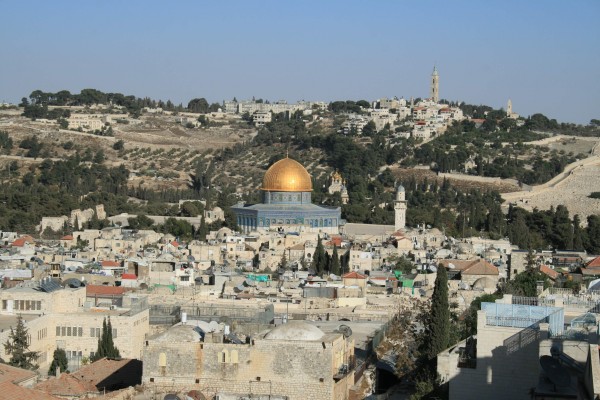
The Dome of the Mount is in the foreground.
Bethlehem is on that hill in the distance
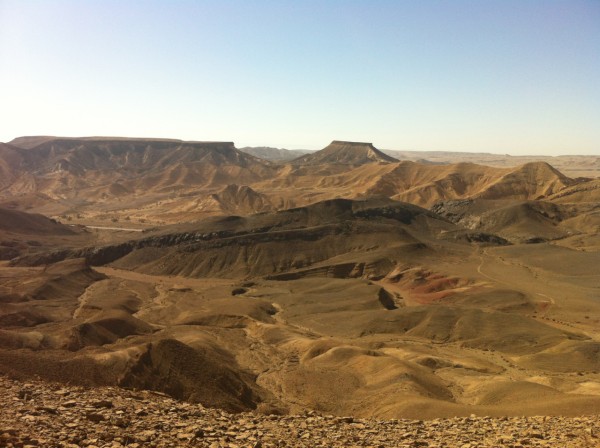
Ramon Crater
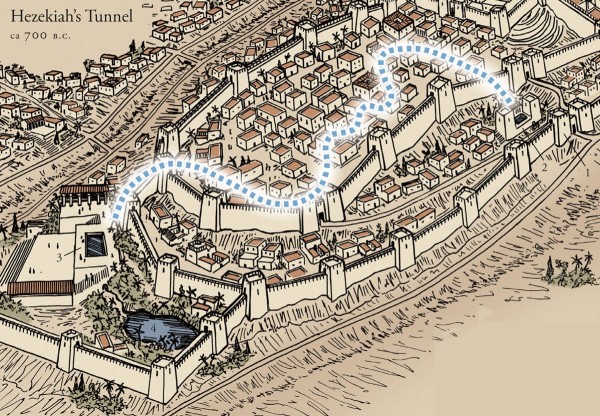
Hezekiah's Tunnel

Next stop: Valletta, the capital of Malta |
Malta is a group of seven
islands in the Mediterranean Sea. Only the three largest
islands - Malta, Gozo and Comino - are inhabited. The
terrain is low and rocky with coastal cliffs.
Malta, in the heart of the Mediterranean, is a melting pot
of civilizations with a history stretching back thousands of
years. The country has been inhabited since around 5200 BC
and a significant prehistoric civilization existed on the
islands prior to the arrival of the Phoenicians who named
the main island Malta, meaning safe haven.
Later the islands were
for centuries the seat of the Order of Knights of the
Hospital of St John and then part of the British Empire.
Malta became independent
in 1964 in a highly peaceful transfer of power.
The national language is
Maltese, which is part of the Semitic language family that
includes Arabic. English is also recognized as an official
language, and many Maltese also speak Italian.
With 7,000 years of history, the Maltese Islands are steeped
in culture and heritage.
This historic legacy, unique in the Mediterranean, is
reflected in the country's national architecture and
collections. There are so many areas of heritage and culture
to be explored - the 16th century masterpiece Grandmasters'
Palace, which is now parliament, the "Sacra Infermeria",
which is now a fully equipped conference centre, the St.
James Centre for Creativity - a superbly restored
fortification where contemporary works of art are exhibited
against the original rough-textured walls and rediscovered
spaces. With these buildings, past and present blend into an
enduring and admirable lesson in the art of living.
The arts have always played a large role in Maltese culture
and continue to do so with cultural events occurring
frequently. The National Museum of Fine Arts, housed in an
exuberant Rococo building dating from the 1570's, exhibits
some magnificent art, ranging from the early Renaissance to
modern times. Both established and budding artists are
encouraged to display their efforts through
publicly-supported programs. There is always an exhibition
of some kind running.
|
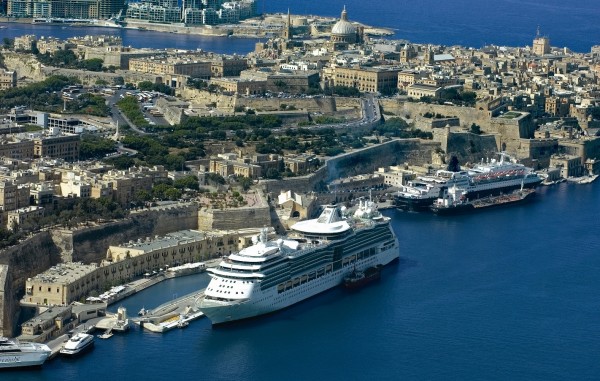
The walled city of Valletta

Next stop: Messina, Sicily |
Sicily
is an amazing island with a rich architectural and
historical heritage, not to mention compelling natural
beauty. It can be overwhelming in many different ways,
especially for a first time visitor. The following is a
list of highlights -- by no means all-encompassing -- but at
least one that will serve as a guide.
Messina is
just three miles off the coast of southern Italys mainland. This bustling town has a
complex history with roots in Greek mythology but because of
an earthquake in the early 1900s, it's a relatively young
city architecturally. Since the majority of the city has
been rebuilt or refurbished within the last 100 years,
you'll find the town has an interesting blend of new
architecture and old styles.
For a show unlike any you've seen before, check out the
world's largest astronomical clock, Orologio Astronomico, in
the Piazza del Duomo. It's set in a 197-foot bell tower and
when the clock strikes noon, it comes to life. As Ave Maria
begins playing from a loudspeaker, the bronze mechanical
figures start to move. A lion roars, a bird flaps its wings,
and two historical heroines take turns ringing the bell, all
before it ends with a statue of Jesus appearing from a tomb.
Other things to do in Messina include taking a walk through
the Duomo, the towns main cathedral in the Piazza del Duomo.
Although most of it has been refurbished in recent years, it
has retained some of the original Norman-style features from
1160, when the Holy Roman Emperor Henry VI built it.
Stop and make a wish in the Fontana di Orione in the center
of the piazza. The pre-baroque-style fountain was built to
commemorate Messinas aqueduct and symbolized the four
rivers, Tiber, Nile, Ebore and Camaro.
Spend some time in the Museo Regionale. Here youll find an
amazing collection of art rescued from the1908 earthquake,
including pieces dating back to the 13th century.
Mount Etna
If
you are more adventurous, a trip to Mount Etna is a
highlight for any visitor to this area. Enjoy a scenic ride
to Europe's largest active volcano. While en route, enjoy
the delightful countryside of vineyards and orchards. The
winding road up the slope passes through vast lava fields to
the Silvestri Spent Craters, almost 6,000 feet above sea
level. There you will be able to walk along the brim of
these craters. You can see remnants of past eruptions.
The road cuts among streams of solidified lava -- a black,
petrified river flowing from the top of the mountain. More
than 130 eruptions have been recorded since the 4th century
BC; the most recent one occurred in 2002. The descent offers
awe-inspiring views of volcanic cones and streams of
hardened lava. Although the best views of the actual peak of
Mt. Etna are from the distance of many miles, a closer
inspection of its powerful destruction cannot help but
impress any visitor.
Taormina
Take a tour to the
well-known resort community of Taormina renowned for
its beautiful setting. It is perched on a mountainside on
the West Coast of Sicily.
Stop below the village of Taormina before proceeding
uphill to the village gates. Upon reaching Taormina, you'll
walk past the ancient village's many squares and see the
small boutiques located along the Corso Umberto. Here you
will find the "essence of Sicily," Taormina. Built in the
3rd century BC, the city was later almost completely
renovated by the Romans. Taormina is perched on a terrace
overlooking the sea. Its medieval character will delight
you. Near the center of Taormina, you will find cobblestone
streets to Palazzo CORVAIA, a 15th century building adorned
with classic double windows. Proceed to the impressive Greek
Theater, built in the 3rd century BC. Renowned for its width
and for its unique acoustic qualities, it is still used for
open-air concerts. Weather permitting; you will have an
impressive view of Mt. Etna.
Enjoy the
busy main street with its numerous shops and cafes and to
savor the charm and atmosphere of this small medieval town
with its palaces, squares, staircases and small side alleys.
Idyllically perched on a rocky promontory high above the
sea, Taormina has been the most popular tourist destination
in Sicily for a couple of hundred of years, ever since it
became an integral part of the Grand Tour. Beautifully
restored mediaeval buildings, breathtaking views around
every corner and a giddy network of winding streets strewn
with shops, bars and restaurants make for a perfect holiday
spot.
Taormina's past is Sicily's history in a microcosm: Greeks,
Romans, Byzantines, Arabs, Normans, Swabians, the French and
the Spanish all came, saw, conquered and left.
Tauromenium, built on Monte Tauro, was founded by Andromacus
at the behest of Dionysius the Tyrant of Syracuse in 392BC.
The first Punic War saw Taormina falling to the Romans in
212BC and the town became a favorite holiday spot for
Patricians and Senators, thus starting Taormina's long
history as a tourist resort
After the fall of the Roman Empire, the Byzantines came only
to be ousted by the Arabs in 962. They changed the name to
Almoezia and set about introducing new agricultural
practices (irrigation and citrus fruit farming) and other
more cerebral pursuits such as philosophy, medicine and
mathematics. Taormina continued to prosper both culturally
and economically with the arrival of the Normans in 1079,
who, under King Roger de Hautville, threw the Arabs out of
Sicily.
After a brief period of Swabian rule, under Frederick II,
Charles of Anjou was pronounced King of Sicily by the Pope.
The people of Taormina refused to recognize this interloper
as their king and, along with a great many other Sicilian
towns, joined in the revolt against French rule during the
Sicilian Vespers of 1282.
A hundred years of uncertainty followed before the Spanish
took over affairs. Evidently impressed with Taormina, they
chose Palazzo Corvaja as the seat of the Sicilian
Parliament.
The rest, as they say, history.
Today, Taormina lives on tourism. Visitors flock from all
over the world to see its Greek-Roman theatre, to amble
along its perfectly preserved Mediaeval streets, to admire
its dramatic views of Mount Etna and to immerse themselves
in the archetypal Mediterranean atmosphere.
The main attraction is, without doubt, the theater. Now home
to all manner of events, including plays, fashion shows,
concerts, and cinema festivals, the Teatro Greco, as its
name suggests, started its life in the 3rd Century BC
hosting performances of works by Aeschylus, Sophocles,
Euripides and Aristophanes. Originally quite small, it was
enlarged by the Romans to accommodate their own particular
brand of theatrical extravaganza. The views from the theater
are spectacular, taking in a (usually) smoking Mount Etna
and the Bay of Naxos down below.
Another testimony of Taormina's ancient origins is the
Odeon. Right in the middle of the old Roman town, just below
Palazzo Corvaja, this small theater was built by the Romans
when the town became a military colony in 21BC. It was used
both for theatrical and musical performances organized for
the cream of local society. Strangely, at some point it
disappeared, only to resurface again in 1892 when a
blacksmith hit upon something that turned out to be red
bricks while digging his land. He dug a little deeper and
called in the experts who uncovered first the cavea, then
the orchestra and finally the scene.
Taormina is centered around its main thoroughfare, Corso
Umberto I. At the beginning of this charming street is
perhaps the greatest symbol of Taormina's long varied
history: Palazzo Corvaja. Its architecture is a sublime mix
of Arab, Norman and Gothic and includes battlements,
mullioned windows and shady courtyards. The Arabs built the
original tower as part of the town's defenses. Its cubic
structure, which is typical of many Arab towers of this
period, is thought to have evoked that of the Ka'aba in
Mecca. In the 13th Century the tower was enlarged by the
Normans who added a wing containing a hall and some
wonderful artwork. The Spanish followed suit, adding another
wing at the beginning of the 15th Century to house the
Sicilian Parliament. Its present name recalls one of the
town's most important noble families who owned the building
from 1538 to 1945.
For the first half of the 20th Century, until after the 2nd
World War, Palazzo Corvaja became a kind of lodging house
for poor families and fell into disrepair. After the war it
was restored to its former glory and in 1960 another section
was added to house the local tourism offices. The main part
now houses the Sicilian Museum of Art and Popular
Traditions.
At the other end of Corso Umberto I is Piazza del Duomo,
complete with 13th Century Cathedral and Baroque fountain.
As with many churches of this period in Sicily, the Duomo,
dedicated to Saint Nicholas of Bari, has a distinctly
fortress-like quality thanks to its robust structure and the
battlements that delineate the roof. Its Renaissance doorway
belies an essentially Gothic interior complete with a rose
window at the west end.
Taormina is served by its very own cable car which ferries
tourists to and from the seaside resorts down along the
coast. Extensive beaches, rocky coves, tiny islands (such as
the famous Isola Bella) and sea stacks abound, making this
enchanting coastline a firm favorite with Sicilians and
visitors alike.
|
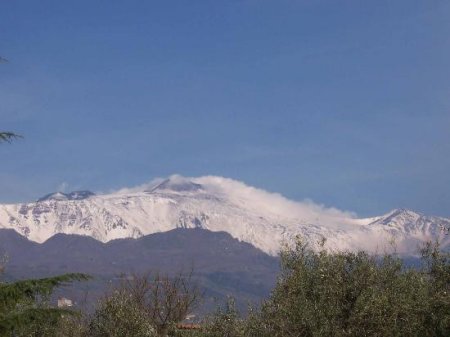
Mount Etna, Sicily
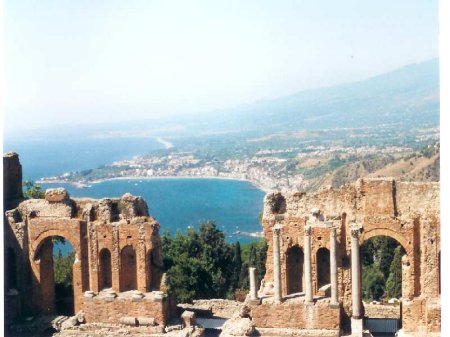
Taormina Overlook
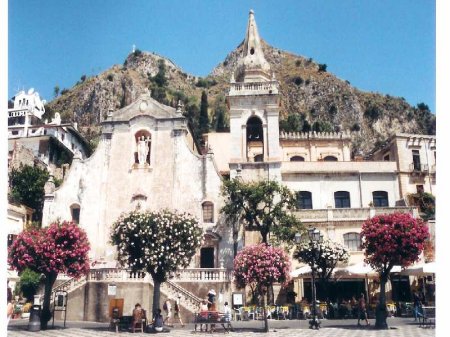
Taormina
Town Square
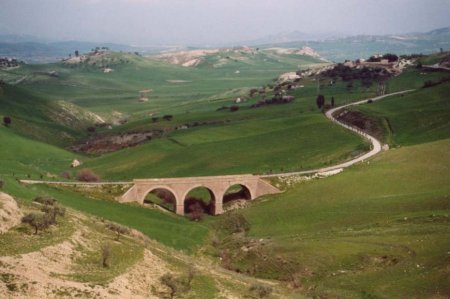
Sicilian countryside
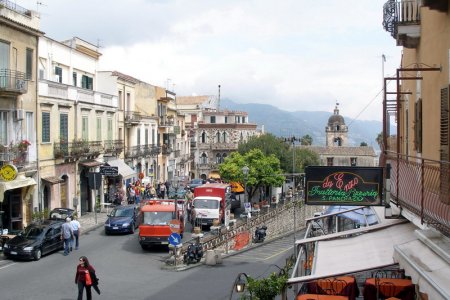
Taormina
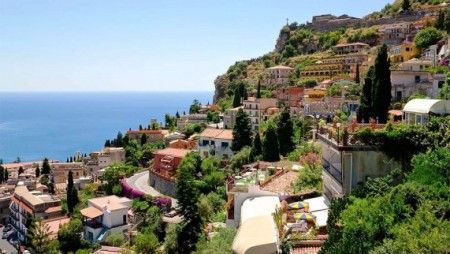
Taormina

Next stop: Naples |
Naples is not
only picturesque, it's also one of the world's greatest
cultural centers, filled with extraordinary works of art and
architecture in the classical Greek and Roman styles.
It is the third most-populated
city in Italy and the biggest city in Southern Italy. Its
name comes from the Greek Neapolis meaning new city.
Its close proximity to many interesting sites, such as
Pompeii and the Bay of Naples, makes it a good base for
exploring the area. Naples is a lively and vibrant city,
full of wonderful historical and artistic treasures and
narrow, and winding streets with small shops.
Naples is in the region of Campania in Southern Italy, about
2-hours south of Rome. It sits on the coast on the northern
edge of the Bay of Naples, one of the most beautiful bays in
Italy. Its harbor is the most important port in Southern
Italy.
Pizza, one of Italy's most famous foods, originated in
Naples and pizza is taken very seriously here. You'll find
lots of great pizza places but be sure you look for one with
a wood-burning oven! Spaghetti also became popular in Naples
and today the best is with clams or mussels. Seafood is
abundant and very good in Naples, too.
Top attractions in Naples include the National Archaelogical
Museum, Duomo, Spaccanapoli district, shopping, the
harbor, castles, and other museums and of course a visit to
Pompeii.
The National Archaeological Museum of Naples,
Museo
Archeologico Nazionale di Napoli, has one of the world's
best collections of Greek and Roman antiquities, including
mosaics, sculptures, gems, glass and silver, and a
collection of Roman erotica from Pompeii. Many of the
objects come from excavations at Pompeii, Herculaneum, and
nearby archaeological sites. The Naples archaeological
museum is one of Italy's top archeology museums and a Naples
must-see site. Highlights include:
Mosaics -
Covering the period from two centuries BC until the eruption
of Vesuvius in 79 AD, most of the mosaics are parts of
floors or walls from Pompeii, Herculaneum, and Stabiae. many
have figures from Greek paintings. The most well-known are
the mosaics from the House of the Faun in Pompeii.
Secret Cabinet - This room was created in the early
1800's to house the museum's many sexual items. It was
closed for many years but reopened in 2000. Visitors must be
at least 11 years old.
Frescoes - Most of the frescoes come from walls in
Pompeii. Covering a period of about two centuries, the
frescoes are excellent examples of Roman painting. They
cover a variety of themes, including mythological,
landscapes, and scenes of daily life.
Temple of Isis- A special exhibit holds wall painting
removed from the temple of Isis in Pompeii as well as
artifacts from the temple.
Pompeii Model - Made in the 19th century, the model
of Pompeii is very detailed and helps the visitor visualize
what it looked like before the eruption.
Sculptures
- The museum has a huge collection of
Greek and Roman sculptures, many of them Greek and Roman.
Coins and Metals - Six rooms containing more than
200,000 coins and medals from Ancient Greece, Rome, medieval
times, and the Bourbon era.
Pompeii
While youre in the area, youll want to visit Pompeii, one
of the most famous excavation sites in the world. A
thriving city 1900 years ago, it was devastated by the
eruption of Mount Vesuvius in 79 A.D. when 30 feet of
volcanic ash and pumice stone cover it. The ruined city of
Pompeii, now dug out from the layers of dried lava that once
swept through it, brings to light the life of 19 centuries
ago and has sparked the imagination of the world.
Numerous myths have
surrounded Pompeii, one of which is that a completely intact
city was rediscovered. Actually, the Pompeians (that is,
those who escaped) returned to their city when the ashes had
cooled and removed some of the most precious treasures from
the resort. But they left plenty behind to be uncovered at a
later date and carted off to museums throughout Europe and
America.
After a long medieval sleep, Pompeii was again brought to
life in the late 16th century, quite by accident, by
architect Domenico Fontana. However, it was in the mid-18th
century that large-scale excavations were launched. Somebody
once remarked that Pompeii's second tragedy was its
rediscovery, that it really should have been left to slumber
for another century or two, when it might have been better
excavated and maintained.
Pompeii is
the most important classical archeological site in Europe.
Its wealth of monumental buildings is unmatched, as is its
collection of mosaics and wall-paintings. But its
architecture and art didnt exist in a void; they were the
framework for a thriving commercial town where 20,000 people
lived, traded, ate, drank, worshipped and frequented
brothels.
Be sure to look for
The Duomo. It is a 13th
century Gothic cathedral dedicated to Naple's patron saint,
San Gennaro. A huge festival is held when a vial of
his blood is taken out of its storage place in hopes that it
will liquefy. On one side of the duomo is the 4th century Basilica Santa Restituta (the oldest church in Naples)
with columns believed to be from the Temple of Apollo, good
ceiling frescoes, and archaeological remains from the Greeks
to the middle ages. The 5th century baptistery has good 14th
century Byzantine-style mosaics.
Spaccanapoli is one of the main streets crossing
Naples and is the heart of the historic center. Teeming with
people, the street holds many interesting churches, shops,
and other buildings. The Spaccanapoli district is a
string of narrow, winding streets and is mainly a pedestrian
zone so its a fun place to wander around. Via San Biagio
dei Librai, in Spaccanopoli, has some of the best
antiquarian book dealers in Italy, terracotta religous and
nativity figurines, and a doll hospital. Via San Gregorio
Armeno is famous for its nativity workshops.
|
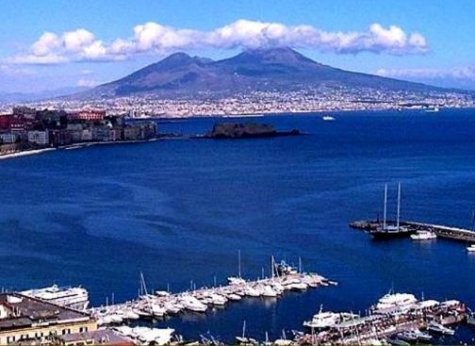
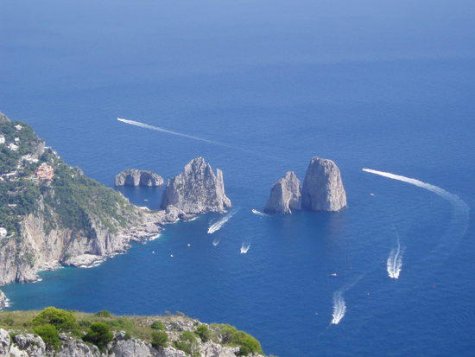
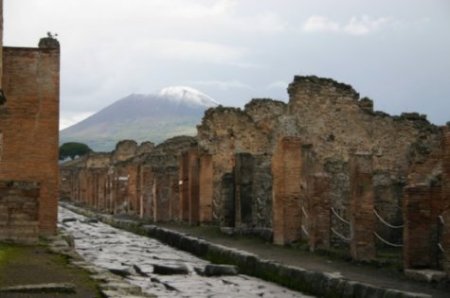
Mount Vesuvius and the tragedy of Pompeii
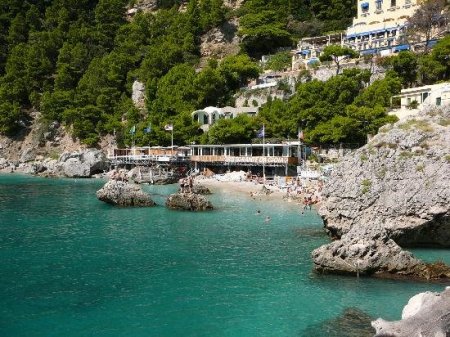

Next stop: Rome |
THE MYTHICAL &
MYSTICAL
ISLE OF CAPRI
|
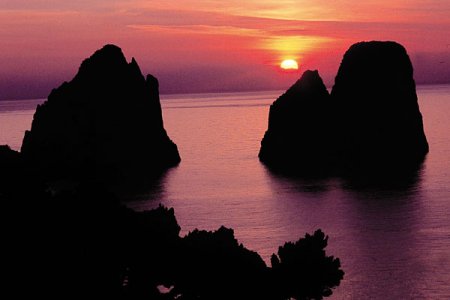 |
| |
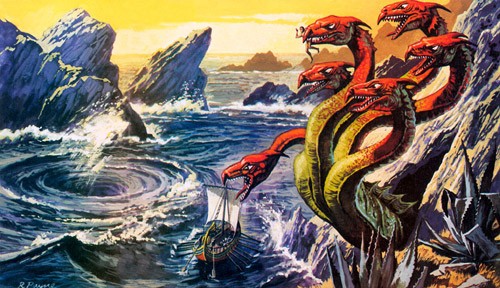
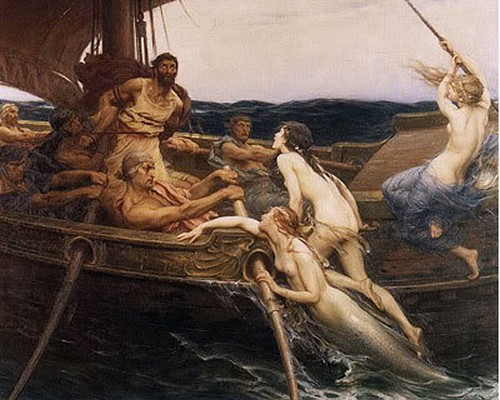 |
The entire
Mediterranean Sea was the domain of the ancient Greeks.
In particular, Homer's Odyssey refers to all sorts of
wild and exotic places where his hero Odysseus wandered to
during his difficult journey home following the Trojan War.
At one time
Homer's Iliad and Odyssey was dismissed as
pure fantasy. However, the surprising discovery of
ancient Troy gave renewed credence to Homer's legends.
Since then, modern scholars have gone to the trouble of
speculating what Mediterranean landmarks might have
corresponded to places referred to in the Odyssey.
For the example,
the narrow strait between Messina and Italy is said to have
been the home of the terrifying monsters Scylla and
Charybdis.
Scylla was a
monster that lived on one side of a narrow channel of water,
opposite its counterpart Charybdis. The two sides of
the strait were within an arrow's range of each other so
close that sailors attempting to avoid Charybdis would pass
too close to Scylla and vice versa. There was no room
for error; any mistake meant doom.
The idiom "between
Scylla and Charybdis" has come to mean being trapped
between two dangers, choosing either of which brings harm.
So if this
danger spot has been associated with the Strait of Messina
between Italy and Sicily, what
role might Capri have played in the Odyssey?
The rugged cliffs of the
Isle of Capri
make it very easy to believe
this stunning
island was exactly where
the seductive sirens called and sang to Odysseus sailors.
The Siren's song was so beautiful
it lured men too close to the shores. Many ships met
their end on the rocks of the island.
To prevent his
men from being shipwrecked,
Odysseus had the sailors ears plugged with wax.
As for himself, he was determined to hear the song of the
Sirens. He had himself tied to the mast
and warned the sailors not to untie him no matter how
much he begged. Although Odysseus
nearly went mad with temptation, he was able to live through
the strange ordeal.
And thats how the cunning Odysseus and his crew managed to
escape being shipwrecked on the Sirens island and imminent
death.
|
|
|
Marla's Note:
Our stop
in Naples will definitely be one of the highlights
of the trip. It will also create a massive
headache for our guests:
Do I
visit Mt. Vesuvius and Pompeii?
Or do I go see the wonderful beauty of the Amalfi
Coastline?
Or do I
visit the stunning Isle of Capri?
These
are questions I cannot answer for you, but I will
say that Rick and I choose "Capri" when we came to
Naples on our 2009 Barcelona cruise. I can add
that Capri is just as beautiful as everyone says it
is. And yes, the women wear nothing but
Capri's day and night (just kidding).
Below is
the research I did for the 2009 trip. And
don't let me forget to point to the extensive story
Rick wrote about our visit.
Rick and Marla Capri 2009
|
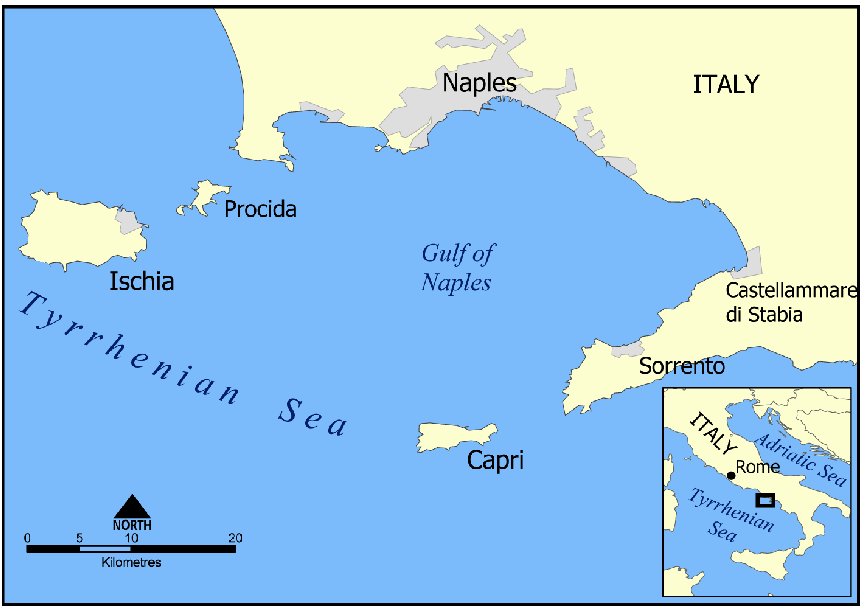 |
|
The Isle of Capri
Written by Marla Archer
Italys most romantic getaway, the
Island of Capri is one of the most scenic
islands in the world. Beautiful whitewashed luxury villas
draped in bougainvillea, rugged cliffs extending down to the
sea and ancient alleyways through medieval villas, Capris
blissful attributes are enchanting.
The Isle of Capri
is only accessible by boat. This
little island on the Bay of Naples near
the Amalfi Coast attracts glitzy jet setters that flock to
the Piazzetta, just as Jackie Onassis and
Audrey Hepburn did when they helped popularize the island in
the 1950s and 60s.
Many of you have heard of Capri Pants.
Capri Pants ("capris") are a style of pants usually worn in
warm weather.
Capri pants were first designed by European fashion
designer, Sonja de Lennart in 1948. Thanks to the
jetset crowd, they grew in popularity during the Fifties
throughout Europe. Capris became popular in the United
States during the 1960s, largely due to the influence of the
popular television series The Dick Van Dyke Show.
The character of Laura Petrie, the young housewife played by
Mary Tyler Moore, caused a fashion sensation and some mild
controversy by wearing snug-fitting capri pants during the
show's run.
The Piazzetta
The
legendary Piazzetta opens out on to a fabulous
view of Monte Solaro. The Piazzetta is the center of the
island of Capri for tourists and locals alike. All those
arriving in Capri have to pass through the narrow passages
left between the tables outside of the various bars.
In the courtyard of the town hall there is the trunk of a
column and a fragment of a circular marble base, discovered
in the 1920s during the construction of the port, and
probably belonging to the Villa Augustea of Palazzo a Mare.
The Piazzetta was the center of local life, where vegetable
and fish markets were held and, where, very infrequently
considering the rarity of the product in times past, meat
was sold. It was not until 1938, when the young Raffaele
Vuotto decided to place a few tables in the square, that the
Piazzetta began to take on a more fashionable appearance.
From that moment onwards the Piazzetta became the focal
point of island social life, which had previously been
carried out predominantly in the towns hotels and in
private houses.
The
Faraglioni Rock Formation
The island of Capri is also
home to mysterious natural wonders. and the massive
rock formations of Faraglioni.
The
Faraglioni are three blocks of rock that have survived
coastal landslides, erosion by the sea and all manner of
atmospheric corrosion. The rocks have each been given a
name: the first, still attached to the land, is called
Stella, the second, separated from the first block by a
stretch of sea; Faraglione di Mezzo and the third,
Faraglione di Fuori or Scopolo, in other words the head or
promontory stretching into the sea. The Faraglione di Fuori
is the habitat for a famous species of blue tinted lizard,
the Lacerta viridens faraglionensis, and is the only place
where it can be found. It is thought that, following the
separation from the mainland; a sort of protective chromatic
adaptation resulted in the lizards scales assuming the blue
tones of the sea and sky. The height of the Faraglioni is,
on average, 100 meters. The Faraglione di Mezzo is
characterized by a cavity, a natural tunnel that has become
famous throughout the world.
Blue
Grotto
The
renowned Blue Grotto
is an incredible underground sea cave that continues
to amaze visitors with its brilliant almost iridescent
waters.
Capris
Blue Grotto is known throughout the world for its size, the
intense blue tones of its interior and the magical silvery
light that emanates from the objects immersed in its waters.
Visitors to the Grotta Azzurra can arrive either by bus or
taxi from Anacapri; or by boat from Marina Grande in one of
the tour boats that stop at the entrance of the cave during
the trip around the island. In order to enter the Grotta
Azzurra visitors climb aboard small rowing boats, with a
capacity for two, maximum three, passengers and, lying on
the bottom of the boat, enter the low and narrow mouth of
the cave.
Entrance to the cave is not possible in the presence of
south westerly and mistral winds. A small natural opening
in the rocky wall forms the entrance to the Grotta Azzurra,
roughly 2 meters wide and 2 meters high. The roof of the
entrance is situated approximately 1 meter above the level
of the sea and, for this reason; passengers are obliged to
lie down in the boat whilst passing in to the cave. The
boatman sets down his rows and maneuvers the boat inside
with the aid of a chain attached to the vault of the
entrance.
The Blue Grottos interior is effused with magnificent blue
tones. The vault, known as the Duomo Azzurro, has an average
height of 7 meters rising to 14 towards the back of cave.
The erosion cavity is approximately 60 meters long and up to
25 meters wide. The cave continues with the Galleria dei
Pilastri, three connecting branches which flow into the Sala
dei Nomi, the name of which was inspired by the numerous
signatures left by visitors on the walls of the cave. Then
there is the Passaggio della Corrosione, and the Sala della
Corrosione, the furthest accessible point. The blue
coloring of the Grotta Azzurra is created by the daylight,
which enters via an underwater opening located immediately
below the entrance to the cave.
The light is filtered by the water, which absorbs the red
tones, leaving only the blue ones to pass into the cave. A
second phenomenon creates the silver appearance of the
objects immersed in the water: given that the index of
refraction of the bubbles of air which adhere to the surface
of the objects is different to that of the water, the light
is allowed to egress. It is believed that, in the Roman
period, under the rule of Tiberius, the interior of the
Grotta Azzurra was used as a marine nymphaeum.
There have been those who imagined the cave as the habitat
of Nereidi or of Sirens or believed it to be the realm of
devils that bewitched all who dared to enter.
The
Tragara
Hike
Great history, nature, and culture have made Capri one of
the most desirable tourist destinations of all times.
Capri has followed a really unique path, from Roman emperors
villas to soul-travelers, and intellectuals of 800 and
beginning of 900, up to the worldly holidays of the
international jet set during the Fifties (which made it
famous all over the world.) Capri is full of natural beauty
and charm.
Tragara is the most famous and best liked walk in
Capri. Via Tragara is
a road of ancient origins built in Roman times, now a
favorite route along which tourists stroll and the address
of a number of luxurious villas.
There are many elegant villas scattered along the way. A
walk not to be missed is to the left, at the end of Via
Camerelle. There is a steep but short path that leads to
Via Tragara, a road that dates back to Roman times. The
road is flat and well kept, lined with hotels, high-class
restaurants, and magnificent villas, of which passers-by can
catch only a glimpse of the entrances amidst the lush
vegetation that screens the property from indiscreet eyes.
Buildings of particular note along Via Tragara include the
German Evangelical Church, built in typical transalpine
style and most unusual for Capri; Villa Discopoli, residence
of the writer Rainer Maria Rilke; Villa Lo Studio where the
poet Pablo Neruda stayed, and the Hotel Punta Tragara, said
to have been designed, if only in part, by the architect Le
Corbusier.
Via Tragara ends with a panoramic terrace with a fabulous
view over the Faraglioni rocks. To the left you can see a
part of the Amalfi Coast and to the right, you can see
houses clinging to the slopes, the castle-topped Monte
Castiglione, Monte Solaro and the bay of Marina Piccola.
From Tragara belvedere, you can enjoy a wide view of the
islands southern side. You will see Marina Piccola that
over hangs the steep face of Mount Solaro, including the big
opening of the Ferns Grotto in the center.
Monte Solaro is the highest part of Capri, towering 589
meters above sea level, and boasting a 360° panorama of the
island of Capri. Monte
Solaro is also called Acchiappanuvole or cloud catcher
after the thick blanket of fog, which forms around the
summit, especially at dawn, when the thermal difference
between the sea and the rock is accentuated. The warmer,
damper sea air condenses in a dense mist on the ground, the
temperature of which has notably diminished during the
night. Where its path is obstructed, the vapors rise upwards
generating a characteristic crown of clouds. This phenomenon
also occurs in the evening, especially in the autumn. The
wind clears away parts of cloud, randomly revealing various
segments of the beautiful island landscape below.
The Tragara Hike takes you to the top of Monte
Solaro. The summit of Monte Solaro can be
reached by foot in approximately an hour and a half.
However, for the
footwork-challenged, as an alternative,
visitors can take the chair lift, thereby arriving at the
peak in just 12 minutes.
Here one finds the ruins of the Fortino di Bruto
built at the start of the 1800s, in the period of the
battles between the English and the French. In the distance
one can identify the mountains of Calabria, the Pennines and
the Amalfi coast, the Sorrentine peninsula, the Gulf of
Naples, and the islands of Procida and Ischia.
At
Cape Massullo, the wildest area of the island, we find
Casa Malaparte. It was the residence of the
Tuscan writer Curzio Malaparte, who called it Casa come
me. Malapartes house is really a unique architectural
event in Capri context. It doesnt follow any of the island
building manners, it doesnt do anything to camouflage into
surroundings and nevertheless we cant imagine any other
place where it could have been built. So much it had
entered into collective way of viewing that it is considered
an integral part of the landscape: in fact this area is
simply called at Malapartes by people from Capri.
On the northwestern
promontory of the island, overhanging two capes of Vertereto
and Arcera, we find another Roman imperial villa called Damecuta,
name of unknown provenance that also indicates the whole
headlands area. For its outstanding, solitary and
defensive position, it recalls Villa Jovis and is probably
another Villa by Tiberius. From Damaecuta you can enjoy a
long range of vision towards the gulf especially Cape Miseno
and Phlegraean islands.
Visitors to Capri are often surprised by the quantity and
variety of walking routes on such a small island. Along
these pathways, tourists can choose to immerse themselves in
the authentic atmosphere of a coastal village, inhabited by
fishermen and sailors; explore the marine caves; walk
through masses of sheer rock and peer over precipices which
drop dramatically into the sea; saunter through the patches
of land cultivated by the country dwellers, planted with
olive groves and orchards of lemon and orange trees; or
stroll through the center of Capri with its ostentatiously
luxurious boutiques, elegant hotels, artists studios,
churches, and the remains of Roman villas.
One of the magical things about Capri is that, even in peak
season in August, when the roads are crowded with tourists,
one can always find a solitary spot in which to rest, or a
hidden bay where to take a romantic
swim in the crystal clear waters.
The enchanted Isle of Capri is indeed a magical place to
visit for a day because so much beauty can be seen wherever
your feet wish to take you!
And now here are some
pictures that will give you an idea of what you will see
when you visit Capri!
|
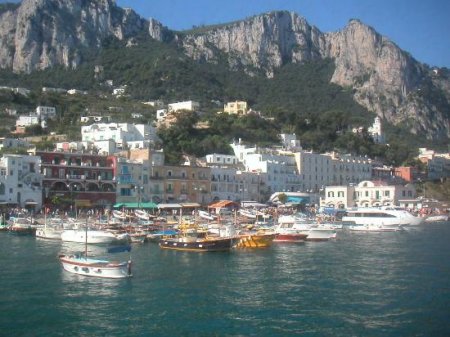
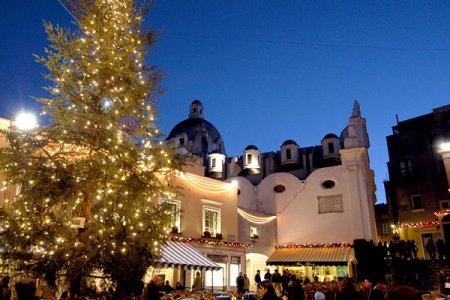
The Piazzetta
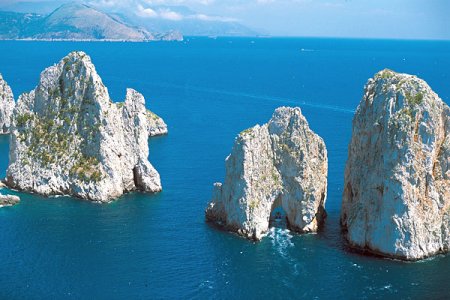
The
massive rock formations of Faraglioni
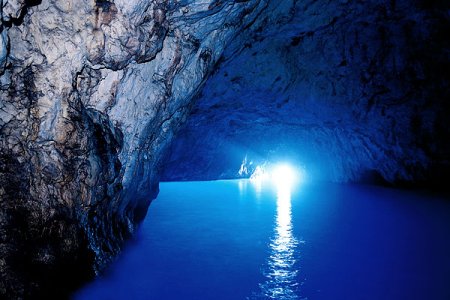
Blue Grotto
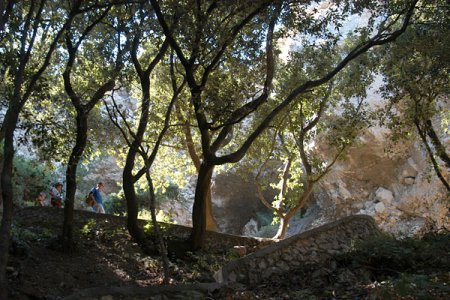
Tragara Hike
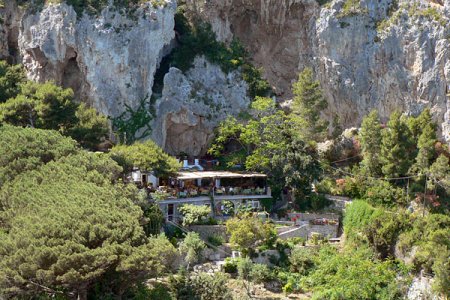
Restaurant
at the top of the Tragara Hike
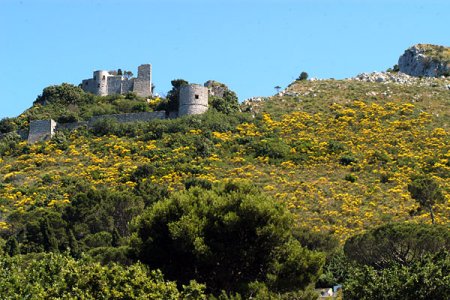
Fortino di Bruto
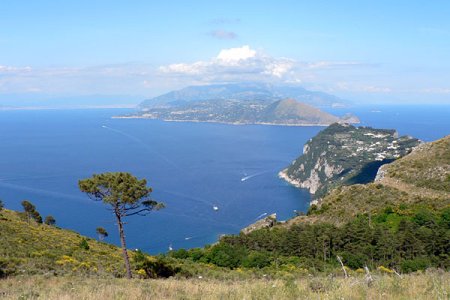
The
island of Procida as seen from Monte Solaro
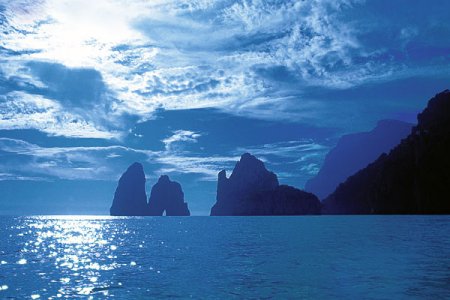
|
Marla's Note:
Our cruise ship does not
actually dock in Rome but rather the port of
Civitavecchia about 40 miles northwest of
downtown Rome.
There are
high-speed trains that take cruise passengers from the ship
into Rome or to Rome's airport. The trip is about an
hour long.
Rick and I have
visited Rome twice previously and consider this magnificent
city an old friend. We welcome the opportunity to
return again; there is always something exciting to see in
Rome. In my opinion, no other city in the world has so
much history standing right in front of your eyes like Rome
does.
Rick and I will
undoubtedly stay two
more days after our Istanbul. I am
certain we will return to Vatican plus Rick has offered to
lead a walking tour through Rome. On our first trip
to Rome, we discovered that many
amazing locations are all within a day's walking distance of
each other. So we intend to take that walk again.
In addition Rick
has promised to protect everyone from the twin dangers of
gelato rip-offs and gladiator picture scams. Although
these modern scourges are every bit as dangerous as Scylla
and Charybdis from Greek mythology, Rick believes if we spot
the dangers soon enough, surely we can avoid them.
Whether it's the Forum, the Sistine
Chapel, the Pantheon or St. Peter's Basilica that sparks
your interest and intellect, Rome is home to a lifetime's
worth of historical, architectural and spiritual sites.
Depending on traffic, the drive from Civitavecchia to Rome
takes approximately an hour and a half.
Experience the history of Rome as you wander around the
Colosseum, one of the most important monuments of ancient
Rome and the Roman forum. A masterpiece of classical
architecture, the Colosseum is an enormous amphitheater
where gladiators, Christians and wild beasts once battled to
the death in front of 55,000 spectators. Upon completion,
spectacular 100-day celebrations were organized as part of
the opening ceremony in 72 AD. Its name is believed to come
from Nero's enormous statue of Colossus that stood close by.
The Forum was designed to be the centre of social, political
and economic life in the city. The innumerable remains
include the well-conserved triumphal arch of Emperor
Septimius Severus, with reliefs depicting his victories and
the base of the Temple of Saturn with its eight columns and
their splendid Ionic capitals. The 'Rostrum' is the famous
platform from which Mark Antony gave his oration in
Shakespeare's play after Julius Caesar's assassination. The
platform became the setting for many important events in
Rome's history. It was named the 'rostrum' after the bows of
the ships that form the decorative motif. The Temple of
Vesta was the home of the Vestal Virgins, charged with
keeping the sacred flame alight. The circular foundations
still remain, near to a garden in which traces of the House
of the Vestal Virgins can still be seen. The Basilica of
Constantine and Massentius was used as the court, and the
three remaining barrel-vaulted naves give an idea of its
gigantic structure. The Arch of Titus celebrates victories
in Judea, and in the reliefs you can see the spoils of war,
including an altar and a seven-armed chandelier. Admission
is free; guide tours in English cost EUR3.20
Be sure to visit the Vatican
Museum, where you can walk through the many rooms that house
the largest art collection in the world. The Vatican is
among the most important historical sites in the world. The
seat of the Holy Roman Catholic Church, The Vatican is also
the home of the Pope. As the smallest state in the world,
the Vatican has figured in key events throughout history.
Occupying about one half kilometer of Rome, The Vatican is
further significant because of its fabulous architecture,
religious, and artistic treasures.
It was Pope Julius II della Rovere
in the 16th century who commissioned Michelangelo to paint
the history of creation on the ceiling of the Sistine
Chapel. Among countless other notable events in the history
of this important city are the convening of the College of
Cardinals, at the death of a reigning Pontiff, for the
purposes of electing a new Pope. No visit to Rome is
complete without an excursion to The Vatican, a place so
steeped in history and tradition that you will never forget
it.
Travel through the magnificent St. Peters Basilica, the
largest church in the world. . Construction began in 1452 on
the site where St. Peter was buried and took over 100 years
to build. It rests on 800 pillars and is littered with 44
altars. During the next 200 years, such famous masters as
Bramante, Michelangelo, Raphael and Bernini worked on its
design and created an unparalleled masterpiece. View
Michelangelo's "Pieta" and the 85-foot-high Bernini Pulpit.
Admire one of the many masterpieces created by Michelangelo,
the famous statue of Moses. This majestic bearded figure is
depicted holding the tablets of the Ten Commandments.
If this is your first visit to Rome time, you must take in
the Sistine Chapel. It is considered a masterpiece of
Renaissance art. Dominating the chapel is Michelangelos
ceiling paining of the Creation of the World.. The Sistine
Chapel receives 50 million monthly visitors. The Chapel was
built somewhere between 1477 and 1481 by Pope Sixtus IV.
From 1480 to 1483, famous artists of Renaissance, such as
Botticelli, Perugino, and Ghirlandaio, decorated the walls.
After twenty years, Julius II commissioned Michelangelo to
decorate the ceiling in 1508. Today, after the restoration,
tourists can visit the chapel and see Michelangelo's Last
Judgment. You will invariably find the Sistine Chapel
crowded with hundreds of tourists, so be prepared. The best
way to see it is to go to the Vatican Museums early, so that
you're among the first in line when they open. Silence
should be observed and photography is not prohibited.
The Pantheon was commissioned by Marcus Agrippa, restored by
Domitian, and subsequently rebuilt by Hadrian (who added the
dome) before being turned into a church in the early 7th
century by Pope Boniface IV. The building's sole source of
light is the opening at the dome's apex (the oculus);
according to popular legend, this formed the base for the
bronze pinecone that is now in the Vatican's 'Pigna'
courtyard, where it is used as a fountain. Many famous
Italians are buried in the Pantheon, including Renaissance
painter Raphael and King Vittorio Emanuele I.
No visit to Rome can be complete without a stop at the
Fontana di Trevi. Tradition has it that throwing a coin over
your left shoulder into the fountain guarantees a swift
return to the world's most beautiful city. Anita Ekberg's
dip in it was immortalized in Fellini's 'La Dolce Vita', and
Italian actor Toto even sold it to an American, passing
himself off as its owner. Earlier it was the setting for the
award-winning "Three Coins in the Fountain" motion picture,
ensuring its popularity worldwide. Designed by Nicola Salvi
for Pope Clemente XII, it was completed in the second half
of the 1700s. The statues in the centre represent Neptune
supported by Tritons on either side while rococo-style Poli
Palace provides the perfect backdrop.
If time permits, take a visit to Trastevere.
This area of Rome was originally built to be a city
port where storehouses held goods at the time of Augustus
and continued to do so until the end of the 19th century. Trastevere then became a downtown market residential quarter
and has now developed into a very desirable quarter. The
heart of the district is Piazza di Santa Maria in Trastevere
with its lovely church, a 17th century palazzo and a
fountain in the middle which is probably Rome's oldest,
having been designed by architects such as Bernini, Fontana
and Della Porta. There are still some well-conserved
medieval houses
If you have the extra time, explore the flavors and history
of Etruscan Italy. Pre-dating the Roman Empire, the Tuscia
region has been the cradle of the Etruscan civilization and
is evident in hilltop Tuscania, with its roots dating from
the 9th century B.C., contrasting with the Renaissance
gardens, fountains, pavilions and maze of Villa Lante.
Rome isn't the only place to visit Italy.
Hardly. Leaving the port area and heading north
from Civitavecchia, you will view the warm colors of the
Etruscan countryside. If you get
the chance, make your way to Bagnaia. Stop by and
appreciate a visit to the Renaissance gardens of Villa Lante.
To create these beautiful gardens, one of the greatest
architects of the time, Vignola, was called upon. Fountains,
pavilions and a box-tree maze were all combined to create a
peaceful yet playful atmosphere.
Walk through these inspirational
and often whimsical gardens, taking time to enjoy the
serenity and beauty of the setting. Then proceed to the lake
of Bolsena and stop for views of the lake and the islands
Bisentina and Martana Standing at the top of a rocky hill
overlooking the Maremma region, Tuscanias Etruscan and
Renaissance buildings have been beautifully restored and
still reflect the Etruscan history. Walk through the narrow
cobblestones lanes of this charming village and take in the
views of the surrounding valleys.
Be sure to take plenty of Euros.
The euro is the currency of the European Union
and the official currency in
Italy. Many stores and restaurants accept major credit
cards, which usually offer a good exchange rate. When
shopping remember there is a value-added tax to most
purchases.
One more thing.
Rick has written two extensive stories about our previous
visits to Rome. If you get the chance to read them,
you will come to realize Rome is an unusually fascinating
place to visit... and maybe a bit challenging as well.
You will soon
learn Rick has gotten into more trouble in Rome than all our
other 30 cruises combined. If you ever want to
irritate him, just whisper "Evil Map of Rome".
Fortunately, I
think he has the place figured out now, but if he doesn't, I
do. Our previous experience should come in handy in
case you have any questions.
Marla Archer
713-862-4428
marla@ssqq.com
|
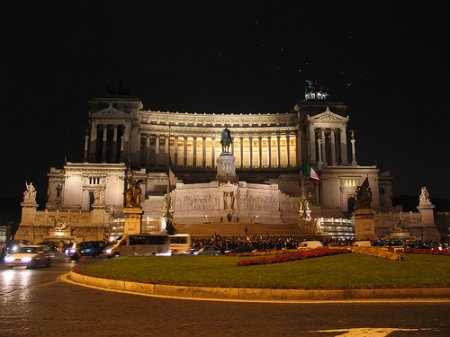
Victor Emanuel Monument
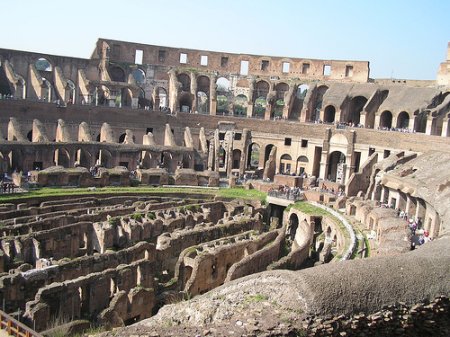
Roman
Coliseum, one the new Wonders of the World
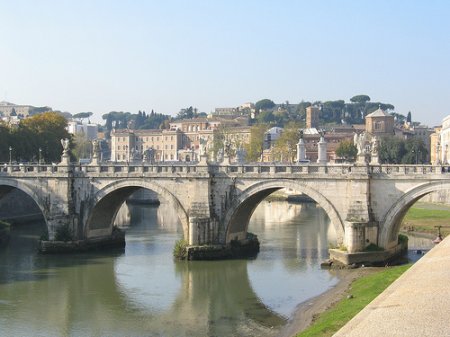
Castle
Saint Angelo
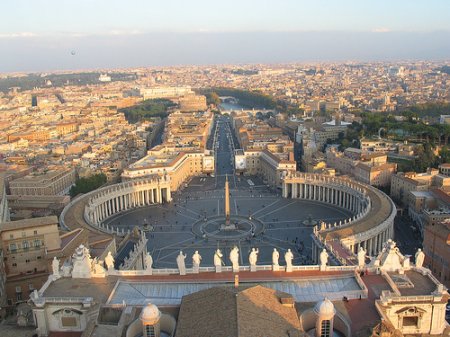
View
from the Basilica
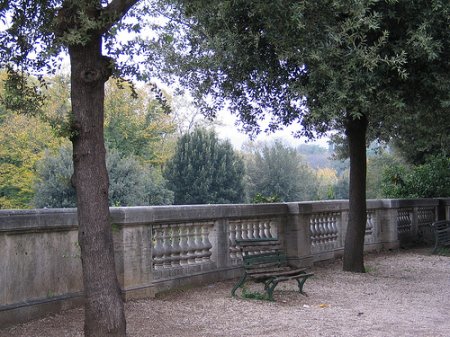
Villa
Borghese Grounds
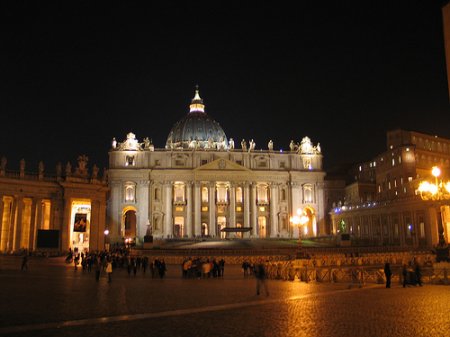
St
Peter's Basilica
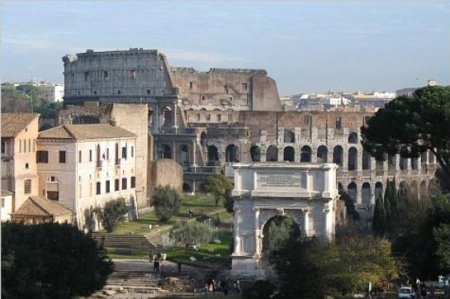
The Roman Coliseum
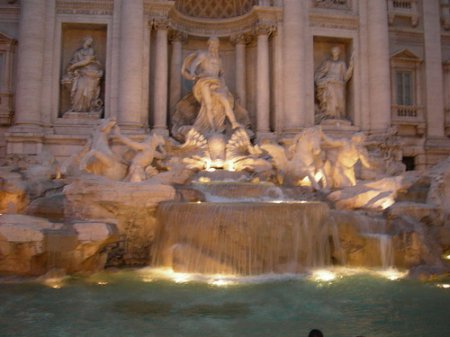
The
Trevi Fountain |
|